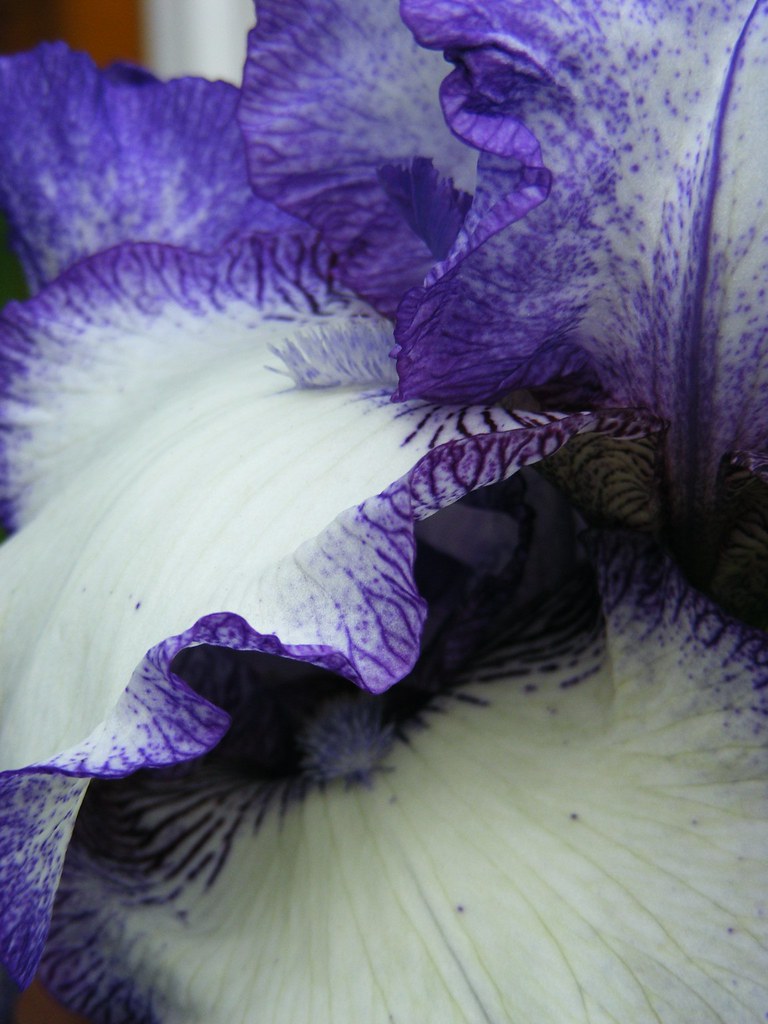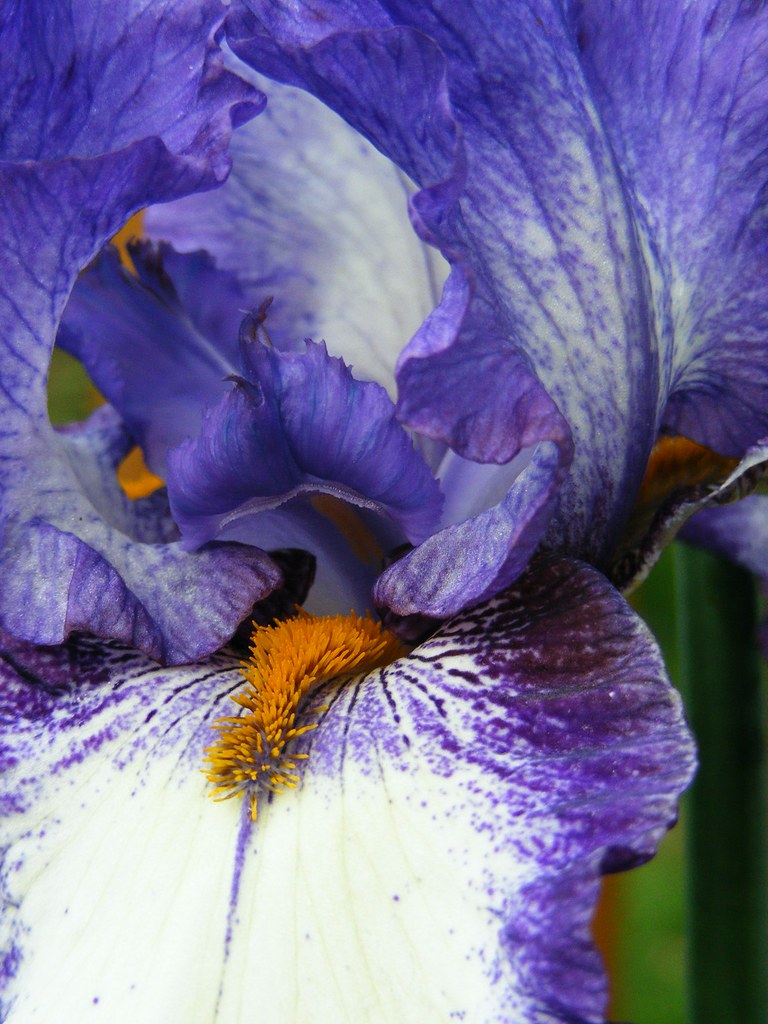skip to main |
skip to sidebar
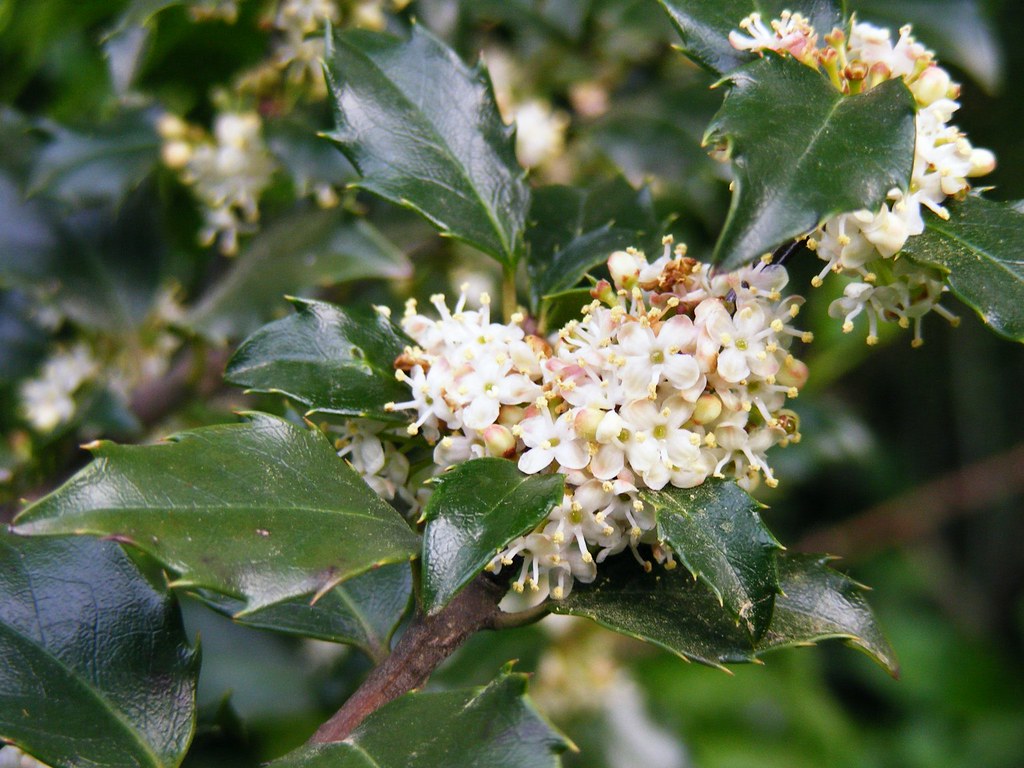 Who knew they were this pretty? (Be sure to click through to the larger version.) I have to admit, I don't usually pay much attention to the Holly Blooms when they arrive in mid-spring, and generally just make a mental note along the lines of, oh, we'll have lots of berries this fall, and pretty much leave it at that. We've both tried a few macro shots in the past, but never have had much luck ... until the arrival of the S700 this year. Last week Fernymoss took another stab at shooting up close and hit pay dirt this time (so to speak). I never imagined they were so pretty --and inviting to insects-- but here they are! Quite lovely, I think ... and I'll pay closer attention to them in the future for sure. I think a lot of gardeners who grow 'Blue Princess' Holly (Ilex meserveae) probably pay much more attention to the brilliant red fall berries than the spring flowers. We've certainly been guilty of that offense! So here's my argument for getting up closer and really appreciating what they're doing to reward us with those lovely berries in the fall (which in our garden do seem to serve as a food source for certain winter birds) to brighten our Holiday decorations (though we hardly cut much at that time, mostly just leggy looking branches).
Who knew they were this pretty? (Be sure to click through to the larger version.) I have to admit, I don't usually pay much attention to the Holly Blooms when they arrive in mid-spring, and generally just make a mental note along the lines of, oh, we'll have lots of berries this fall, and pretty much leave it at that. We've both tried a few macro shots in the past, but never have had much luck ... until the arrival of the S700 this year. Last week Fernymoss took another stab at shooting up close and hit pay dirt this time (so to speak). I never imagined they were so pretty --and inviting to insects-- but here they are! Quite lovely, I think ... and I'll pay closer attention to them in the future for sure. I think a lot of gardeners who grow 'Blue Princess' Holly (Ilex meserveae) probably pay much more attention to the brilliant red fall berries than the spring flowers. We've certainly been guilty of that offense! So here's my argument for getting up closer and really appreciating what they're doing to reward us with those lovely berries in the fall (which in our garden do seem to serve as a food source for certain winter birds) to brighten our Holiday decorations (though we hardly cut much at that time, mostly just leggy looking branches).
If you've been wanting to grow Holly and haven't yet tried it, a few words of advice: avoid direct sun and plant it in a nicely organic loam, not super rich, nor poor or rocky, where they will stay moderately moist in the hottest months of the summer, and you should be able to keep them happy. We have three bushes planted in our Woodland Garden on the north side (2 females and 1 male) where they get a few hours of indirect east and west sun during the day. Just bright enough that they can grow vigorously, but not intense enough to toast them in the sun. It also helps to make sure you have at least one male and female plant (they're usually identified as 'Blue Prince' or 'Blue Princess' at garden centers) planted not too far away if you want to have berries in the fall/winter. Though I've heard of self-pollinating varieties, I know nothing about them or whether they really can pollinate themselves. When we put these in (in Spring, 1999), the only options were to buy both male and female plants to achieve pollination, thus berries. Once you've got your hollies all planted and situated, be prepared to be very patient, because they are initially very slow growers and may spend the first couple of years looking like they've barely grown at all. This is actually a bit of a mixed blessing, because Holly can grow very tall (up to 10-12 feet at maturity!) and they're a lot easier to manage while they stay relatively small and compact. I'd guess that over the nine years they've been in our garden, they have put on perhaps about 3 feet, (they were about a foot tall when planted), and though they've lost some branches the last couple of winters, due to ice storms and heavy snows. Other than that, they've been really tough troopers in the shade garden and continue to reward us all year round with their evergreen interest and attractive berries.
I can't emphasize enough how much they will suffer in direct sun. My sister has been trying to grow one for years (longer than us) and it continues to struggle because of its position, at the edge of her garden (though under a small maple) in a full Southern exposure. I just told her (again) last weekend that it's getting cooked and wants more shade because it looks "toasty" and never produces berries. It's a good thing she doesn't read this blog, because I think the only solution for her is to buy a male and female and plant them in full shade all over again ... Yeah, that's harsh, but sometimes my didactic side comes out strongly about certain plants. At least I finally got her to quit planting Bleeding Hearts in full sun and move them to shade ... now she raves about how well they do! I'm really happy for her on that one ... now if I could convince her about the Holly, lol.
One minor quibble with the Missouri Botanical Garden link above: they say full sun to part shade, to which I say, with our fiercely hot summers, full sun is out of the question if you want them to do well. Maybe it's just the soil where we have them, but the few morning and afternoon hours of indirect sun seem to suit them quite well.
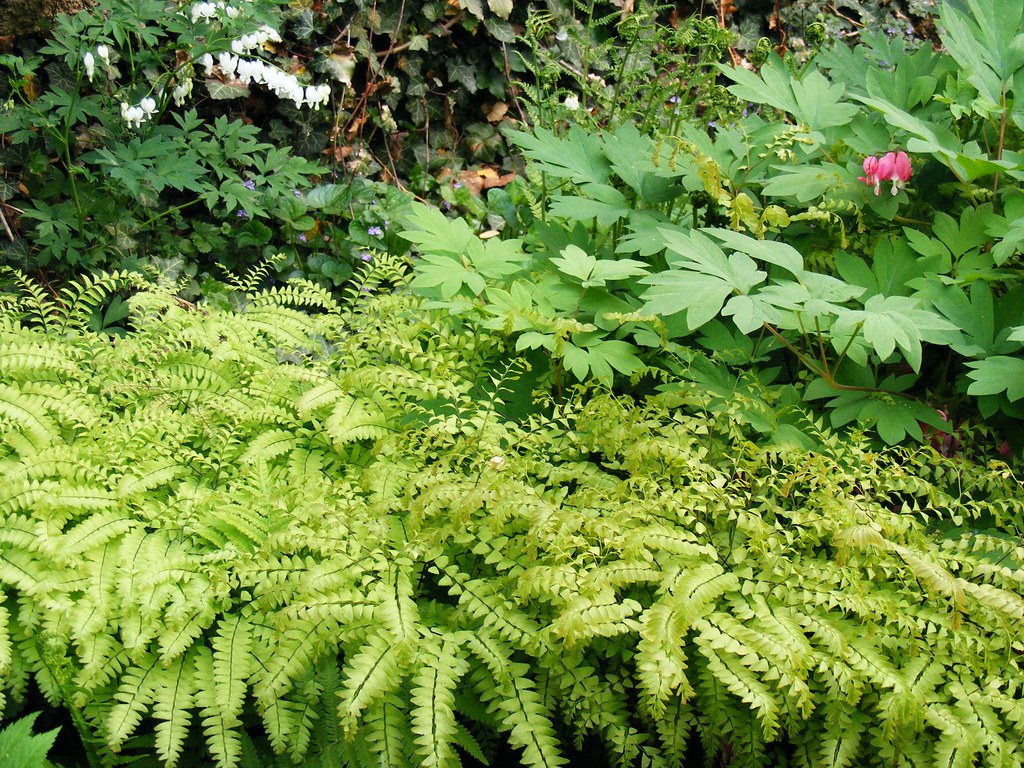
 One more fernscape for a quietly spent Memorial Day ... It's a wider shot of the ferns and Dicentra we have in the middle space of the Woodland Garden, just behind the Hollies.
One more fernscape for a quietly spent Memorial Day ... It's a wider shot of the ferns and Dicentra we have in the middle space of the Woodland Garden, just behind the Hollies.
Though it was still pretty muddy today out in the garden, I did manage to spend a couple more hours working on the small bed next to the front steps. (The one with the primroses.) It has been in dire need of a good raking and weeding and general clean up before I could get serious about getting it planted for summer. So now, aside from re-placing the rocks at the front of the border, it's ready to get planting. In fact, my reward to myself today was planting one of the coleus we got over the weekend ... it's a really colourful one with lots of veining ... called "Peter's Wonder" if you happen to see it when out shopping. (For Iowa readers, it came from HyVee.)
This has always been a challenging little bed (about 3'x3') to achieve a measure of success and make it look really good. When we first moved here, there were a few perennials planted there: mainly a small Meadow Sage (Salvia nemerosa), some struggling small clumps of Bee Balm ... everything in it was basically struggling due to a thick overgrown mass of the dreaded 'Privet Lilies' that run rampant across the gardens and yards of just about everyone in our part of town. Well, as soon as I heard from a friend (who lives out in the country) that she was looking for a lot of daylilies to screen her a bit from a ditch, I was wheeling and dealing. (Because we can't get rid of these in the back either because they grow under the fenceline.) Here's where I landed: I proposed giving said friend all the daylilies she could haul or manage to plant (especially from this bed!), but politely suggested that should she ever want to thin her peonies out (I'd heard her mention this before), we'd sure be grateful to give them a new home. You see where this is going now ... a few weeks later at work she said she had peonies for us and had them in a box in her car. Deal sealed and two gardeners came out happy at the end. So the very first peonies we ever planted were Elaine's peonies, since they originally came from her. You'll be seeing them soon, when the peonies finally start blooming, and I'll point hers out.
Currently this little bed is undergoing yet another overhaul of sorts, though we've slowly been adding some more perennials over the past few years to see what would really take off, some Munstead Lavender, ferny red yarrow, an Artemisia 'Silver Mound' that ended up being one of last year's casualties due to the cold. But the real success story is the Primroses (see previous crowing on this subject) and now, apparently, the new Toad Lily I put in last year (a lovely purple one!) is quite happy in its new space as well. So currently, aside from a few snowdrops who are starting to naturalize and that rogue red tulip, that's pretty much the content of this little bed. The trellis is testimony to several past failures with clematis and (supposedly perennial) passion flower vines, but now we're just planting morning glories and Spanish Flag (Mina lobata) on it, which is much less worry and hassle.
So this is what I'm planting soon (probably tomorrow if it's not too rainy): I'm going to add another 'Silver Mound' where it once was doing quite well, I already planted one coleus and I think I'll add a few more. Then come the seeds ... Nasturtiums up front by the rocks, a small patch (on the sunnier, driveway side) of Balsam and a few Cerinthe seeds, just to see what comes of them this year. And, if I happen to find a new Toad Lily that wows me, I might put another of those in by the other one in the hope that they eventually colonize like some of our others have. Other than that, I plan to let this design go and do its thing (hopefully well!) ...
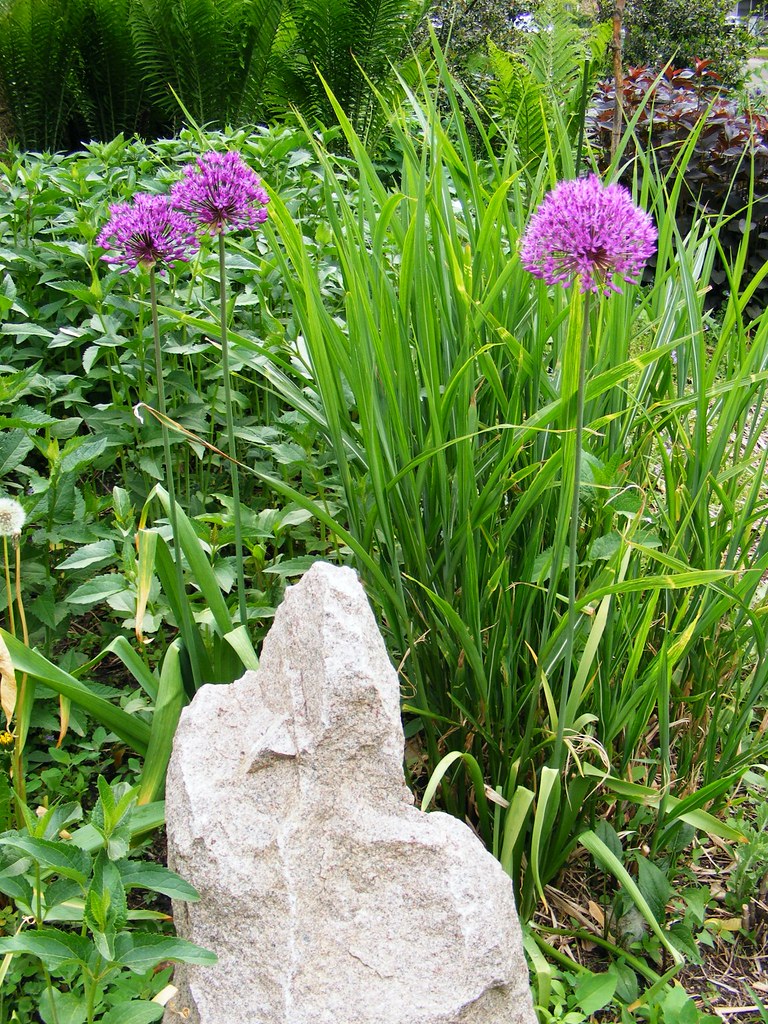
 These two photos by Fernymoss, (taken on 22 May, 2008), show a couple of different perspectives of one of (what we consider) the highlights in the front boulder garden: Finger Rock. I think the nickname is pretty self-explanatory, but if not, we call it that because that's what image it summons up for us! When we had that huge pile of boulders and rocks to start with, we saw immediately that a few really had potential as accents in the garden we were building, and this was one of the first we put aside until the appropriate placement emerged in the bed. (Which didn't take too long once we started filling it all in!)
These two photos by Fernymoss, (taken on 22 May, 2008), show a couple of different perspectives of one of (what we consider) the highlights in the front boulder garden: Finger Rock. I think the nickname is pretty self-explanatory, but if not, we call it that because that's what image it summons up for us! When we had that huge pile of boulders and rocks to start with, we saw immediately that a few really had potential as accents in the garden we were building, and this was one of the first we put aside until the appropriate placement emerged in the bed. (Which didn't take too long once we started filling it all in!)
Let's look at them one by one ...
The first photo reveals a lot, first and foremost, the Globe Alliums that are currently demanding attention from behind the rock ... Directly behind it and a bit to the right is 'Porcupine Grass' (Miscanthus sinensis), a vigorous and very attractive tall grass we have really come to love in the past few years. Its only real drawback is that it's really easy to slice yourself up if you're unfortunate enough to get entangled with it (as I did last year when I slipped and fell backwards into it, causing some nasty cuts and lacerated skin), so admire from a distance! That veritable 'field' to the left is 'Bee Balm' (aka Monarda didyma), one of our real show stoppers come mid-June to early July, with its fiery red blooms massed in the ever increasing space it inhabits. This is one of the plants we share freely with interested gardeners because not only can it have a tendency to 'take over,' it actually appreciates and is stimulated by division every couple of years. We just dig up a good sized clump, fill in with topsoil and it's soon populated heavily again. It's a mint, remember ... and all mints have somewhat of an 'enthusiastic grower' reputation (to put it diplomatically!) In the background, you can see our (also ever increasing) stand of Ostrich Plume Ferns (Matteuccia struthiopteris), another of our fond memory favorites. (Boran2 are these the ones you have?) To the right of the ferns you can see Lysimachia vulgaris, a start of which was given to us by a gardening friend who swore it was yellow Bee Balm (though it bears no resemblance to it!) It's beautiful, but a bit of a thug, and we need to tame it a bit and dig a good bit up and get rid of it this year, either to willing takers or to the compost. The foliage is a very attractive reddish-maroon colour, and the profuse yellow flowers it produces in July and August are very pretty indeed. (You'll see more of this as it develops over the summer.)
The second shot is obviously dominated by this quite attractive Artemisia, the name of which I've forgotten,since we didn't save the plant tag that came with it (a common practice here, alas). I haven't had much luck determining exactly what it is, but it's pretty enough we like having it where is right now. It gets a bit unruly (e.g. threatens to take over) after it blooms (which is going to be soon, if you look closely), but we usually just give it a quick pruning (definitely cutting off the flowers, which are nothing to write home about!) and that seems to keep it in line for the rest of the summer. There are tons of seedlings in this shot, namely Zebrina Mallow, Calendulas and our neighborhood favorite, "Frank's Poppies" that are coming up all over the garden, getting ready to wow the passersby again this year. I think I can also spot a few 'Bells of Ireland' seedlings in this shot as well, though they tend to concentrate toward the front of the bed ... additionally you can see the last of our spring bulbs, Hyacinthoides hispanica, or 'Spanish Bluebells' or 'Wood Hyacinth.' These guys have really been spreading the past couple of years and we couldn't be more pleased to see them do that! When I originally planted these in fall 2005, I had purchased them from Park Seed, who claimed they were Scilla hispanica, so I was initially fooled into believing we just had a later blooming species of Scilla, even if they didn't even vaguely resemble Scilla's foliage or bloom type. That sent me to the Google of course, and I soon learned they were really a member of the Liliaceae and more closely related to the Hyacinths, which made a whole lot more sense. But what's in a name? They were a steal when I got them ... I got a box of 100 (yep, a hundred!) for $5, so they're showing up all over the place out front and along the walk. Every year they just seem to bloom better and better, and they were spared last year's late freeze period because they hadn't come up yet when we had that cold spell. And it's kind of nice to know that all the bulbs are definitely done when these bloom ... it provides a nice season changer to know that other flowers are about to claim the 'star' mantle in the display.
One last plant I'd like to point out is the 'Sea Holly' (Eryngium giganteum 'Miss Wilmot's Ghost'), one of our favorites that is close to achieving 'weed status' in its current position, but it's so unusual and pretty (and has the advantage of attracting many beneficial wasps) that I don't have the heart to go after it too aggressively (though Fernymoss has his differences with me on that particular issue!) Again, you'll be seeing more of it in future posts, but if you're curious at this point, just click the 'Sea Holly' label below and you'll get a preview of what's to come.
So that's the state of the garden at this point, and since I have some time off from work this week, I'll be out a few hours every day, weeding and planting our new annuals and perennials, as well as seeds as I get the areas cleared. Today, I cleaned out the small bed with the Primroses, in preparation to planting some coleus, nasturtiums, balsam, lupine seeds. The Toad Lily out there is already looking good in its second year and I expect great things from it come late summer ... so much to get done, but somehow we always seem to pull it off somehow! And with all the plants we got over the past two days, we have our hands full!
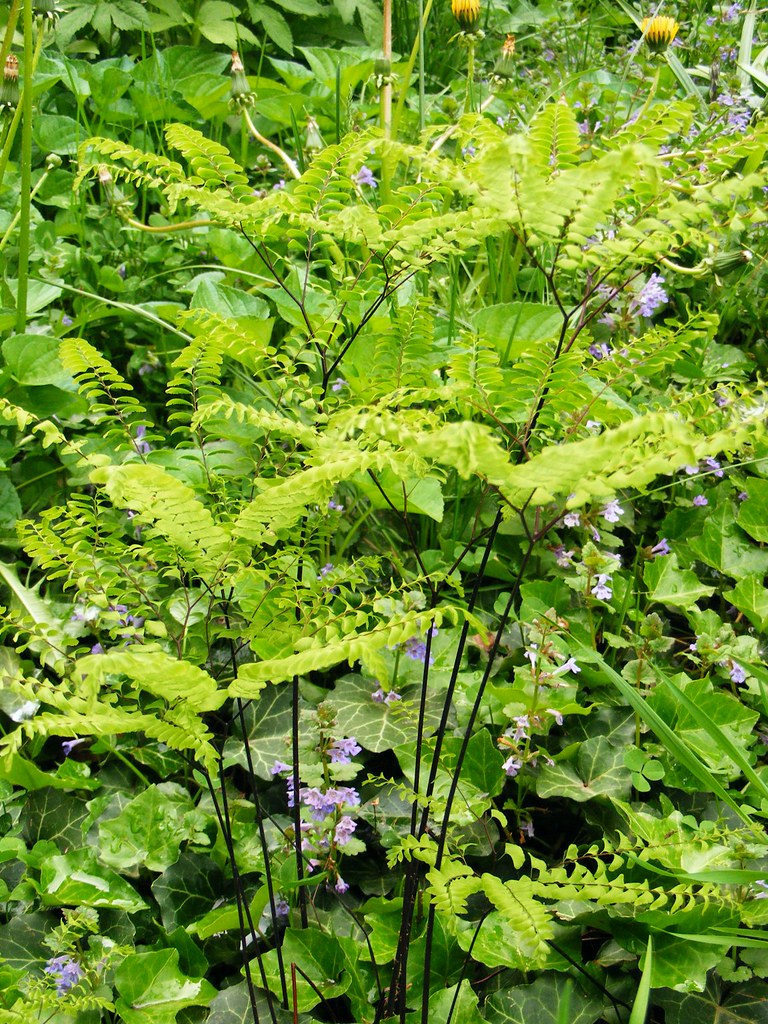

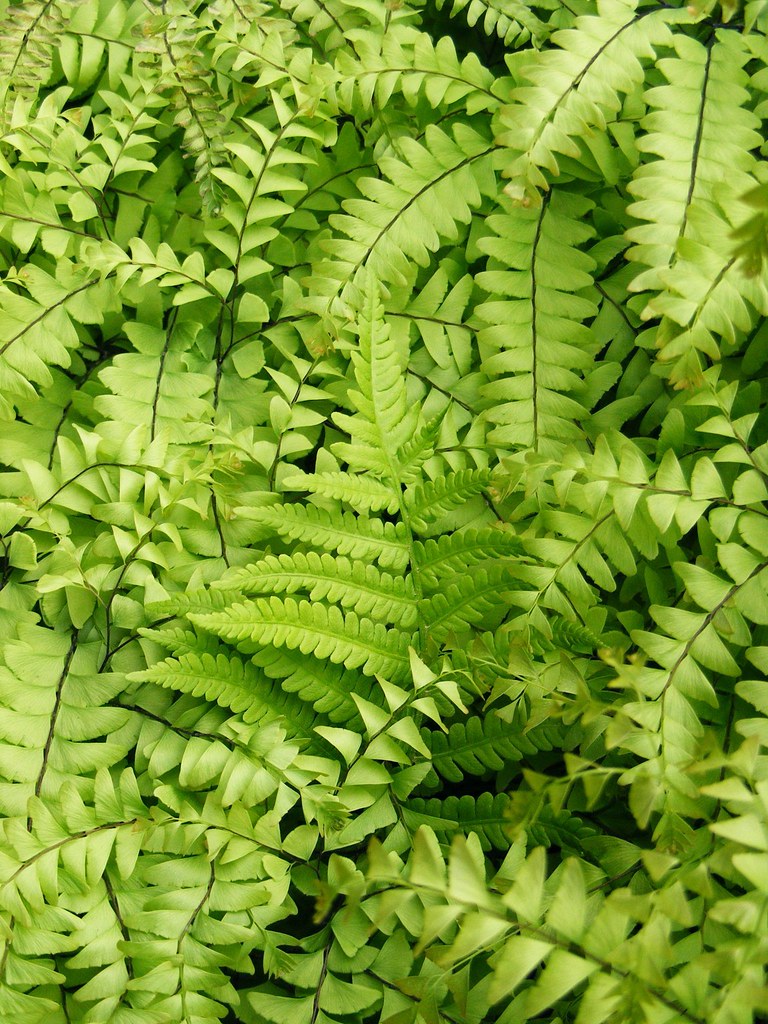 I left today's selection of photos up to Fernymoss and he chose these enthusiastic and burgeoning Maidenhair Ferns.
I left today's selection of photos up to Fernymoss and he chose these enthusiastic and burgeoning Maidenhair Ferns.
As regular visitors already know, we're quite the fans of ferns in our Woodland Garden area and we've gradually increased our Maidenhair (Adiantum pedatum) population over the years, and they've been steady colonizers around these areas, sharing space with the Leatherwoods and Ostrich Plume and other varieties of ferns we have planted.
I asked Fernymoss what he'd want to say about these ferns and he recalled his memories of traveling and camping in the Boundary Waters of Northern Minnesota, where he was indelibly struck by the image of going by ditches positively filled with Maidenhairs and wild Lupines.
From his perspective, the image conjured up these ferns, seejmingly floating a foot above the ground ... which I thought was a really good description because they do appear to float above anything planted below them (in this case the ivy and ground ivy --a weedy mint that we let bloom before we go after it).
For such a delicate looking fern, Maidenhairs are incredibly hardy, from sub-arctic North America to the far South across a pretty wide swath of the US. As far as cultivation, they've been really easy for us, but that's due in large part, I think, to sheer positioning. Most ferns want fairly bright shade at some point of the day, but will not tolerate blazing direct sun, without quickly giving up the ghost. They also demand a fairly organically defined (peaty, loamy) and consistently moist soil, such as woodland situations provide. Fulfill those very basic needs and anyone should be able to succeed quickly with Maidenhairs.
In successive years, they'll spread gradually out from the parent plant(s) by offshoots, as well as some of the spores that tend to move around the garden. At this point, we have so many that it's impossible to determine which ones were the original plants. We just delight in their (and our) success in making themselves at home in our shady areas ...
Photos by Fernymoss, taken 22 May, 2008.
 Late this afternoon, I was reminded of this immortal line uttered by Billie Burke (Glinda, Good Witch of the North) to the Wicked Witch of the West (the inimitable Margaret Hamilton).
Late this afternoon, I was reminded of this immortal line uttered by Billie Burke (Glinda, Good Witch of the North) to the Wicked Witch of the West (the inimitable Margaret Hamilton).
Hillary Clinton, you better take note after your poisonous intimation today that Barack Obama might be assassinated like Robert F. Kennedy in June, 1968, and you'd need to step in and assume the nomination. "Beyond the pale" doesn't begin to describe the downright toxic behavior (say, during this whole campaign) Hillary Clinton has demonstrated over the past few months, and which culminated with this reprehensible remark.
This vile piece of sociopathic projection has, fortunately, gotten a lot of media coverage tonight, but if you haven't seen the video yet, Huffington Post has it up here. This casual, off the cuff "freudian slip" (as if you can wear one of those things under a pantsuit?) made to the editorial staff of a South Dakota newspaper literally hit me like a punch in the solar plexus. And I'm still not over it. It is the ultimate last (beyond the last one) straw cementing my divorce from anything even remotely related to the Clintons. Yes, I railed on them in an earlier post last month, and since then, my feelings have only hardened into lifelong loathing for them now for what they have done to the Democratic party, all in the name of their own lust to power. It is, as Keith Olbermann said tonight in a Special Comment about Hillary Clinton, just plain unforgivable. And that arrogant, hubristic pseudo-apology issued later only "adds insult to injury," said Eugene Robinson of the Washington Post. She offered some lukewarm sop to the Kennedys, while issuing the usual "if anyone was offended, I regret ... blah blah" claptrap that the Republicans have committed to memory so well. Not once did she mention Barack Obama, or as Keith Olbermann noted, "the entire American People" for re-opening this particular wound.
My childhood was seemingly filled with assassinations ... JFK when I was in kindergarten ... and that fateful year of 1968 when it seemed the world went crazy and we lost, in rapid succession, Malcolm X earlier in 1965, Martin Luther King and Robert F. Kennedy. The reason I still tear up at that thought of Kennedy is that in 1968 I was politically aware enough to know that he was bringing hope and a sense of renewal to our battered country ... and I saw all the footage on TV, which has since been seared on my brain. I wept, as yet another man offering to change the course of the nation had his life snuffed out by some unhinged person. I've been seeing some eerie parallels with 1968 this year, and it makes me more than a little bit uneasy about our prospects of even having a valid election this year. But that's a whole 'nother post I'll spare you.
The point I really want to make is, that lately, I've been seeing a disturbing pattern emerge with high profile people floating the trial balloon that there might be an attempt on Obama's life. Yes, Mike Huckabee can use his aw shucks it was just a joke defense, but the fact remains that he put it out there, and in a sense gave it life. After all, he was addressing the NRA when he let loose with that sickening attempt at levity. I don't care which candidate you support, the point is: this stuff is just not within the bounds of civilized discourse during a political campaign. Period. You don't just go around making jokes about shooting political candidates. Period. You can bet that had some ordinary schmo said this on camera, on national television, about the $hrub or Darth Cheney, they'd have been staring down some bars in the big house in record time. It constitutes a veiled inference to incite violence, and that's a line that no politician should ever dare to cross. As Olbermann said tonight, that is the "third rail of American politics" that should not, under any circumstances, be violated. And he's right.
As William S. Burroughs wrote, Language is a virus, and the very action of setting a virus loose in the general population is an invitation to disaster. And that is precisely what Huckabee and Clinton have done, and in the latter case, repeatedly. She has stoked the smoldering fires of racism in West Virginia, and just this week Kentucky (states she 'won' and are unlikely to vote Democratic this fall, anyway ... the same argument she has leveled repeatedly at Obama, you know, in those states that 'don't count' like Iowa).
My second thought, after summoning up Glinda's admonition was, Will someone please drop a house on her, now? She has broached the bounds of acceptable political discourse one time too many, and she should take full responsibility for such a hateful and irresponsible comment. She knew full well what she was (in all likelihood desperation) putting out there, and anyone who continues to buy her more than six week old putrid tripe is, in my estimation, a fool. If those are the positions you support, then you should vote for McBush, because with this unhinged and increasingly detached from reality creature, you're getting pretty much the same bill of goods.
But I should at least mention the third item that really cemented this current meme in my mind, so here it is. In a suburban Atlanta paper, the Roswell Beacon, the cover story this week was entitled White Fright and pictured Barack Obama in the crosshairs of a rifle. Jason Linkins, over at Huffington Post wrote an eye opening piece that raises some very unsettling questions about the campaign to come. Thanks again, Hillary, for poking that hornets' nest of racist sentiment in the South. And, if you can stomach the utterances of some of her West Virginia voters, go take a look at NPR's report here (h/t Carpetbagger Report's Steve Benen). It will likely turn your stomach to think that people in this day and age can still utter such hateful nonsense.
We have a lot of healing that must take place in this country before we can even begin putting things back into a more sane perspective. Let alone respecting the Constitution and restoring our lost civil rights swept aside by $hrub and the $hrub Crime Family in control for much of the last 20 years. And fueling the violent fantasies of some elements in our society is not a good way to start. I'm talking to you, Hillary Clinton, and the rest of those hate mongers who espouse essentially the same mindset (Huckabee, you too, just go away and shut up!).
Yes, I've been outraged tonight, but it's the culmination of watching the past eight years go by with a continual degradation of our bedrock Constitutional principles sent to the proverbial toilet and duly flushed that has me most enraged. I just don't recognize the country I was brought up to revere and cherish. We have been overtaken by the pod people and I just fervently wish that people will wake up and do something to correct it before it's too late.
Barack Obama is offering us hope, a change in the status quo and a new political paradigm. Hillary Clinton offers us regression to the politics of fear and personal annihilation, and I'm more than willing to give him his chance at greatness. Something tells me that he might actually pull it off. And for that alone, SHE must be relegated to the 'also ran' category now. You've got at least a dozen forks in you now, you're done. Just go away and let the healing begin.
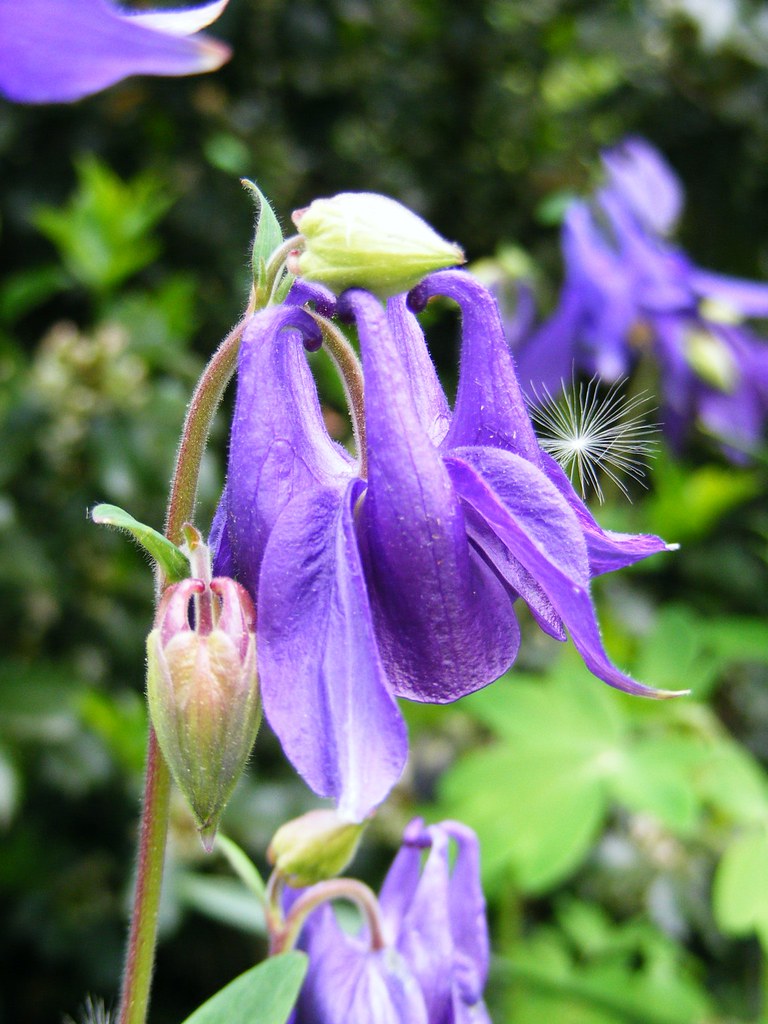
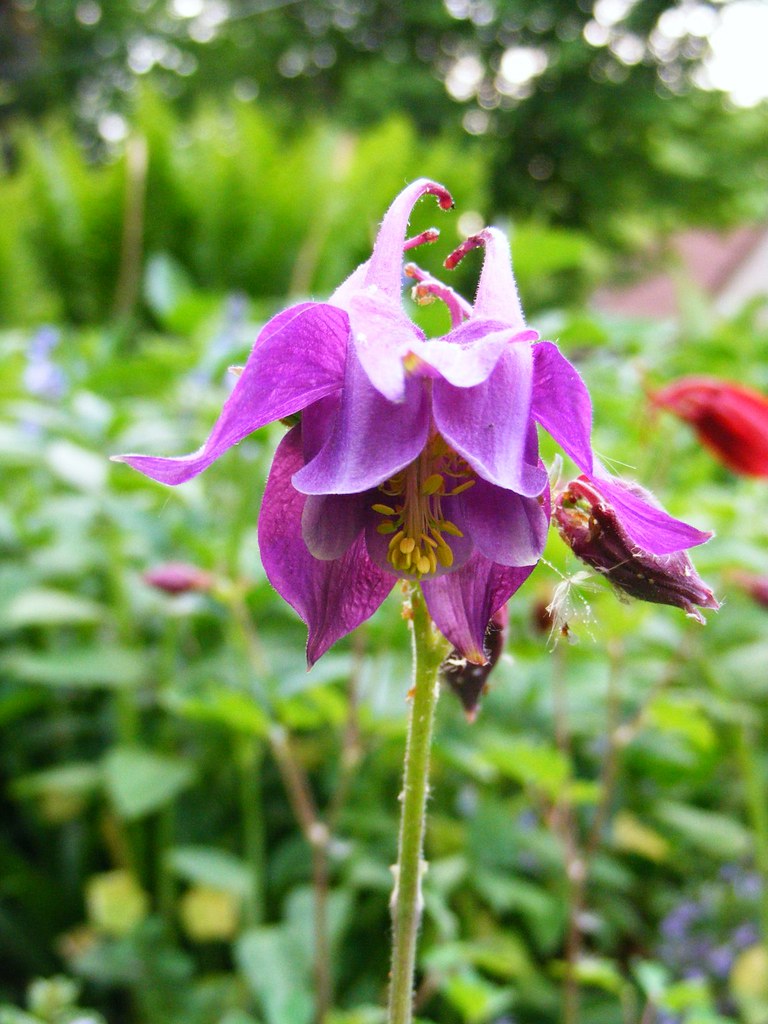 Just in the past past few days, the Columbines (Aquilegia sp.) have really started to bloom in earnest, and if early indications are any sign, it looks to be a good year for them, despite the harsh winter. I haven't gone looking for all of them yet (we have them scattered about in the garden), but it sure looks like all the ones we really like are back and healthy this year. So ... for tonight's post, enjoy a few early previews of three of our prized specimens...
Just in the past past few days, the Columbines (Aquilegia sp.) have really started to bloom in earnest, and if early indications are any sign, it looks to be a good year for them, despite the harsh winter. I haven't gone looking for all of them yet (we have them scattered about in the garden), but it sure looks like all the ones we really like are back and healthy this year. So ... for tonight's post, enjoy a few early previews of three of our prized specimens...
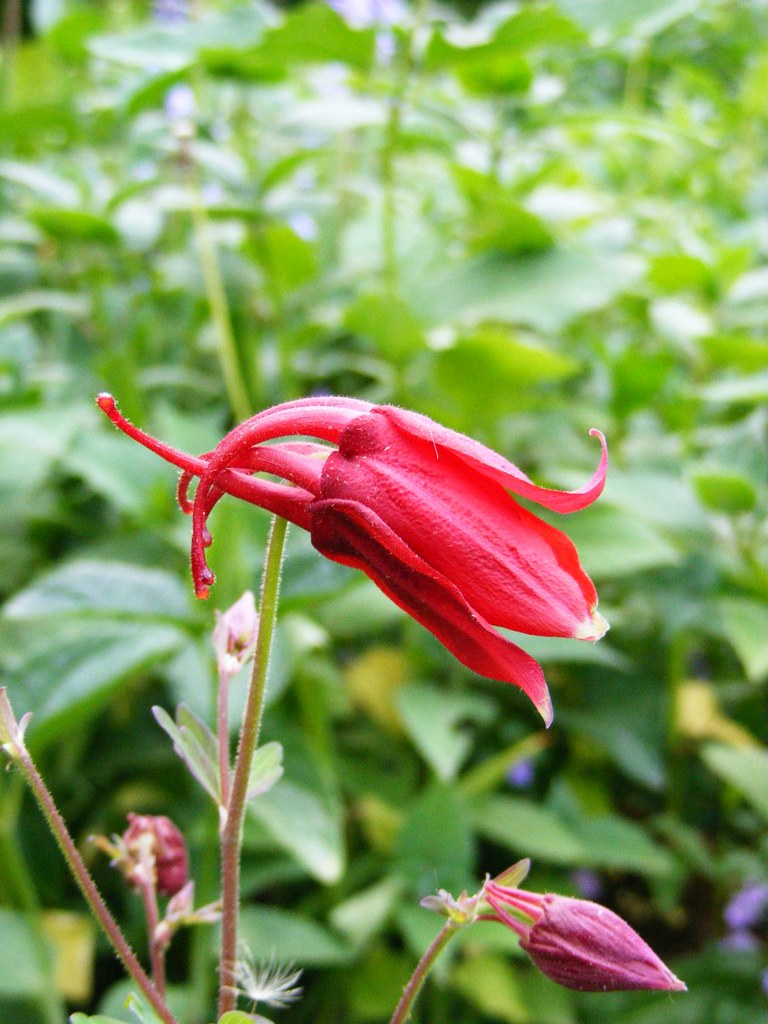 IAboy, over at An Iowa Garden, posted some new Columbines ('Barlow' hyrbrids, I believe) he had purchased the other day and was talking about how these supposedly easy, incredibly lovely flowers have been such a challenge for him for many years. As such, he didn't hold out much hope for his new ones.
IAboy, over at An Iowa Garden, posted some new Columbines ('Barlow' hyrbrids, I believe) he had purchased the other day and was talking about how these supposedly easy, incredibly lovely flowers have been such a challenge for him for many years. As such, he didn't hold out much hope for his new ones.
We share a similar history with him in that we tried in vain for several years to make Columbines happy in our garden ... with pathetic results for the most part. But we've learned a few things about them over the years and finally have seemed to met their needs, at least in several areas where we have them planted. At least at present ... We now think we've cracked a few of their secrets, which I'll share with you, if you, too, are struggling with making them grow.
The first mistake we made was buying all 'Barlow' Hybrid varieties, some of the fancier, more intensively bred cultivars. They never established themselves vigorously the first year and made one more lackluster appearance the following (with about 2-3 flowers, I recall), then promptly checked out without paying the floral bill. I don't even remember what the other colours were now, but the point is: every single one of them died pretty quickly. I'm sure some people are more successful with the 'Barlows,' and I commend them, but we're completely soured on them at this point. That doesn't mean that we wouldn't take in a homeless 'Barlow' (we'd probably give it a chance) but we wouldn't go looking for one either!
The second mistake we made was to plant them in too much shade, where they did try to grow, but never got very big, didn't bloom much, and also didn't stick around for more than 2-3 years. Contrary to what most instructions say, they are not a deep shade plant. They want and need at least several hours of pretty strong sun to perform really well. Our successful ones get a mix of east-south exposure early in the day, some east-north-west exposure in the afternoon, and those are the ones that are thriving for us .. at least for now.
The third conclusion to which we came merely acknowledged what we think to be simple fact: Aquilegia, technically speaking, is a perennial, albeit a relatively short-lived one. So we must be prepared for some inevitable die-off every year or so. Something we've been experimenting with a bit is to plant them in proximity, to allow the numerous seeds to fall and make a stand in the area, in order to replace the older ones as they die off. The results aren't in yet (these have only been there about 3 years), but we suspect that might also be one secret to success. Another strategy we've pursued (mine, mostly) is to buy two or three each year (preferably of these varieties) and plant them near the more established plants ... sort of hedging bets against the future, so to speak.So far it seems to be paying off ... I'm envious when I chat or correspond with gardeners, for whom Columbines have achieved weed status in their yard/garden. And, from observations we've made driving around the city, they seem to do best and develop into real colonies on street corners! Our thinking now is that we pampered them to death with our first efforts (however misguided) and that they really prefer a poorish soil and more sun that usually believed. The Alpine Blues in this post are in an area that doesn't have a richer soil, but it has excellent rocky, sandy drainage ... At this point, we think that just might be the trick to establishing a larger colony of Columbines.
Some points to think about though, if you're considering adding Aquilegia to your perennial beds... I don't claim to be an expert, but that's been our experience so far.
Here are last year's blooms ... I'm constantly amazed between the colours on the old Fuji 2650, compared to the new S700! And here are the Alpine Blues from last year ... we LOVE the S700 now. It is our master ....
Photos by Fernymoss, 22 May, 2008. With the awesome S700 ...

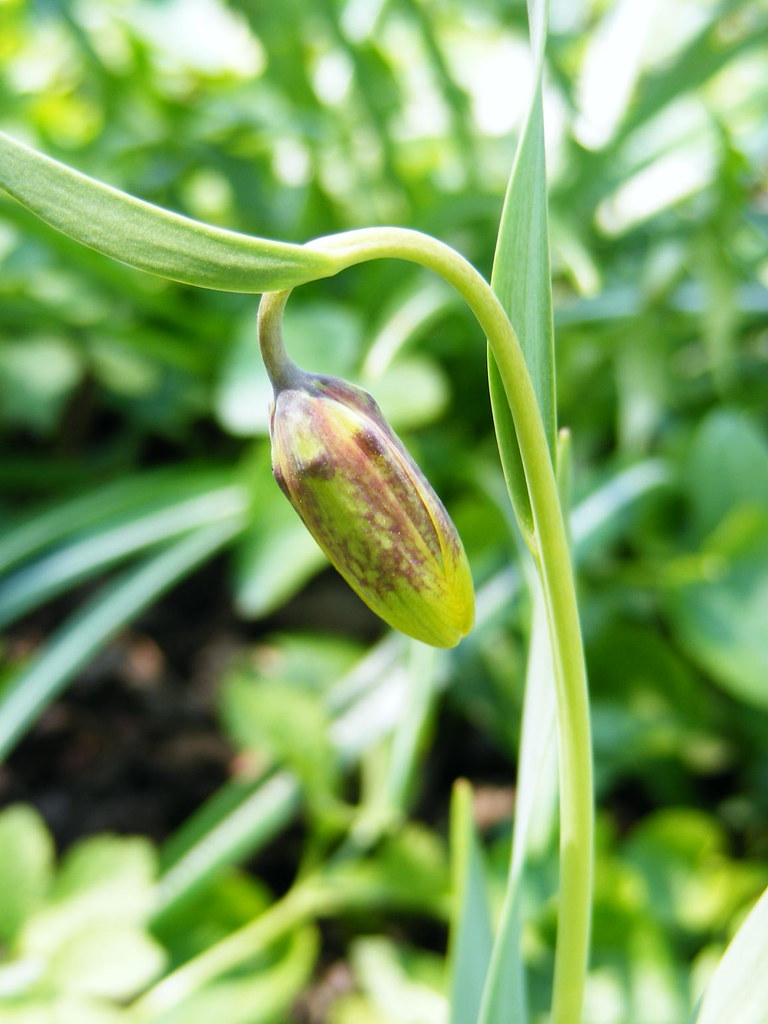 Funny how quickly the 'archives' of spring bulb pictures get outdated in the mad rush to bloom in which so many flowers compete at this time of year ... We took these shots back in late April and of course, at this point, they've already packed up and gone away for the rest of the season. But I thought I'd post them anyway, as a fond farewell to the early spring bulbs ... but there are still Wood Hyacinths (Hyacinthoides hispanica or 'Spanish Bluebells') just starting to bloom now so they'll be the absolute last of the truly spring bulbs to do their thing.
Funny how quickly the 'archives' of spring bulb pictures get outdated in the mad rush to bloom in which so many flowers compete at this time of year ... We took these shots back in late April and of course, at this point, they've already packed up and gone away for the rest of the season. But I thought I'd post them anyway, as a fond farewell to the early spring bulbs ... but there are still Wood Hyacinths (Hyacinthoides hispanica or 'Spanish Bluebells') just starting to bloom now so they'll be the absolute last of the truly spring bulbs to do their thing.
Fritillaria michailovski was the first Fritillary we ever planted years ago (thank you Martha Stewart, lol) and though I think there were originally about six, but they've dwindled over the years, most likely due to the rather poor spot we chose to plant them (at the edge of the sidewalk, where they're almost too small to see up close) and some harsh winters, as well as last year's disastrous spring. But when we planted them, our first bulb bed was brand new, and the front boulder bed was only a dream that had not yet been accomplished. But still, they persevere and this year we vow to dig up that bed, re-do it and transfer these lovely little fellows (natives to Turkey, of all places!) to a more prominent spot in the front border for next spring. We also plan on getting some more to increase their numbers, because having a nice little mass of F. michailovski would make a great companion to other early bloomers such as the Snowdrops and Crocus (which was the original idea where we have them planted now), so hopefully we'll just move the whole lot to some newer spots and give them a little more prominence next year. I've whined enough this spring about last year's débacle (and I promise to stop!) but I thought you might be interested in seeing how they looked last year. They definitely did better this year! (Notice the difference in quality between the old Fuji and the new one -- the S700-- I'm constantly amazed at how much richer colours the new one captures!)
Next week I am taking a week's vacation to really get out and get serious in the garden, as planting season (especially for veggies) is quickly slipping away from us after what has seemed like such a brief nice period of spring! There's still a lot of clean up and weeding to be done (the dandelions are done, so out they go!), so I hope to tackle a bit each day I'm off and get areas weeded and planted with some of the new plants we already have. Fernymoss actually has this weekend off so we're probably going to get some new plants, do some digging and weeding and get down to business ... then fire up the grill for the season! Can't wait to cook my first pork tenderloin on the grill this year ... that's our new favorite, and after all, if it's summer (with the World Pork Expo coming up in early June), we gotta have our tasty Iowa Pork! It's right up there with the sweet corn, but we'll have to wait a bit longer for that, I'm afraid ...
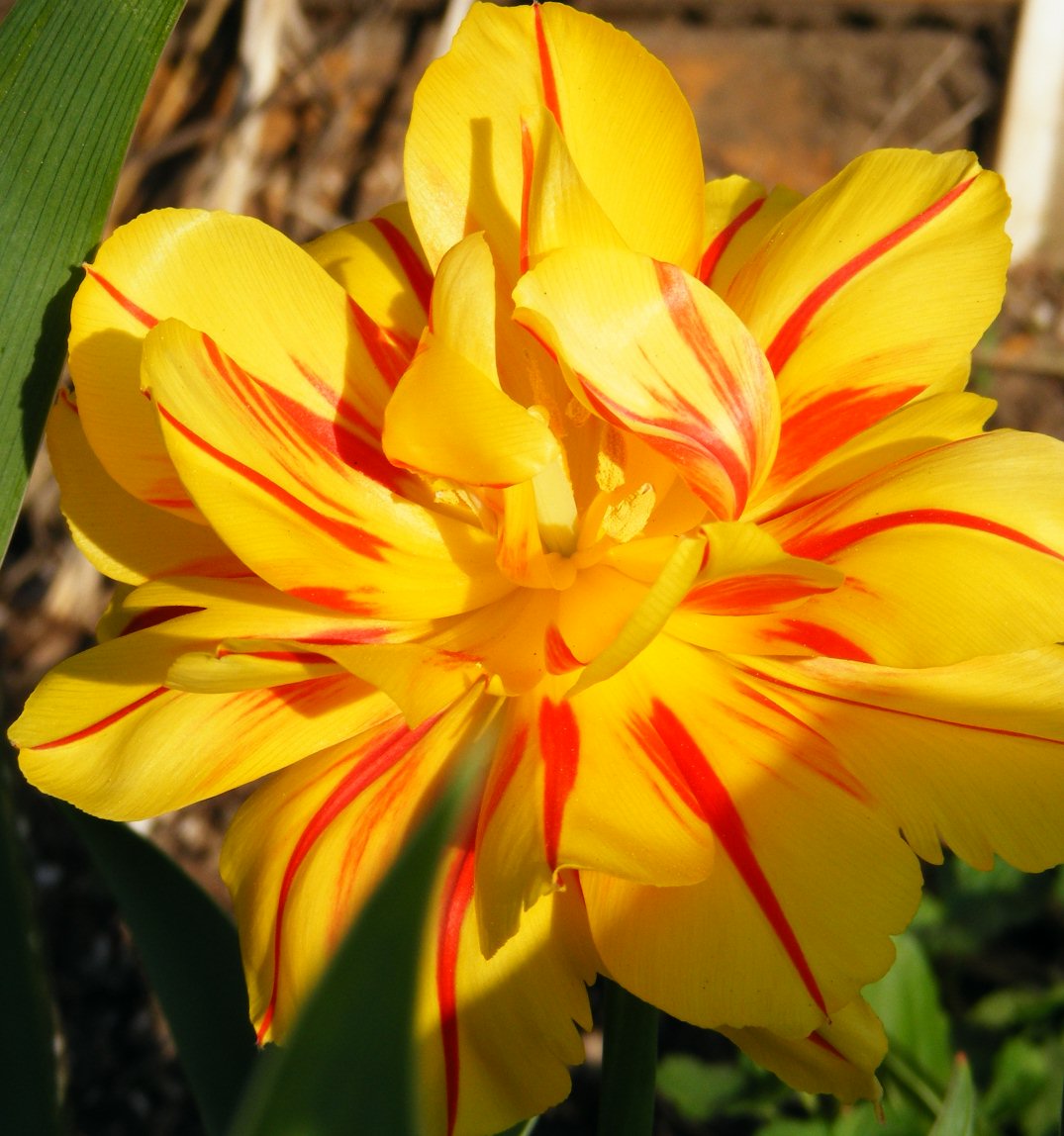 As those who know me will attest, I'm a huge fan of fire coloured flowers, especially those in the yellow to orange range. Now I'll admit first off, that these gorgeous tulips are not from our garden (we should have been so lucky this year!), but are from our neighbor's yard across the street. (He's the cool guy who, in late 2002, left a huge pile of boulders in our yard ... the ones that eventually became the front boulder bed.)
As those who know me will attest, I'm a huge fan of fire coloured flowers, especially those in the yellow to orange range. Now I'll admit first off, that these gorgeous tulips are not from our garden (we should have been so lucky this year!), but are from our neighbor's yard across the street. (He's the cool guy who, in late 2002, left a huge pile of boulders in our yard ... the ones that eventually became the front boulder bed.)
 A couple of years ago he bought an enormous number of tulips of all sorts at a late season sale and had his helpers plant them, quite literally all around his place. I don't quite understand how they managed to escape the carnage ours suffered, but they sure were a welcome sight on the block recently, given our paltry number of blooms. What's odd is that he had a bunch of daffodils planted too, but they have largely disappeared this year (along with a lot of others' daffodils), but most of the tulips did quite well. Go figure ... we had a great year for Daffodils, but the Tulips largely disappeared, but when you cross the street, the opposite situation occurred. Ah, the vicissitudes of Iowa weather ....
A couple of years ago he bought an enormous number of tulips of all sorts at a late season sale and had his helpers plant them, quite literally all around his place. I don't quite understand how they managed to escape the carnage ours suffered, but they sure were a welcome sight on the block recently, given our paltry number of blooms. What's odd is that he had a bunch of daffodils planted too, but they have largely disappeared this year (along with a lot of others' daffodils), but most of the tulips did quite well. Go figure ... we had a great year for Daffodils, but the Tulips largely disappeared, but when you cross the street, the opposite situation occurred. Ah, the vicissitudes of Iowa weather ....
Photos by Fernymoss, taken on 6 May, 2008.
 Today's post is a bit of this and that, thrown together quickly, just to show some of the new color coming to the front boulder bed soon. I've been having a lot of allergies (trees are blooming) and intense sinus headaches the past week or so, and today was not a great one, nor tonight, thus the slapped together nature of this post!
Today's post is a bit of this and that, thrown together quickly, just to show some of the new color coming to the front boulder bed soon. I've been having a lot of allergies (trees are blooming) and intense sinus headaches the past week or so, and today was not a great one, nor tonight, thus the slapped together nature of this post!
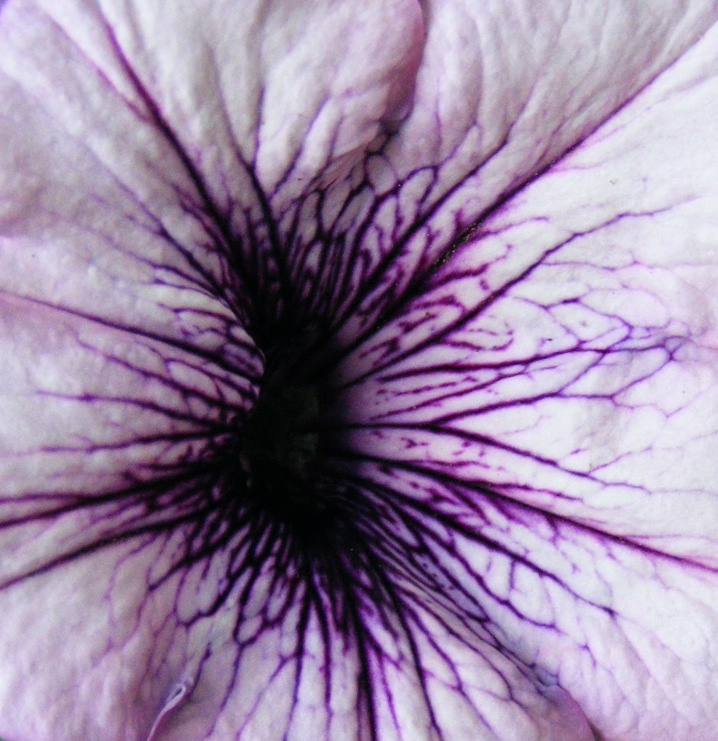 A week or so ago we went plant shopping (still a lot to get!) and these were two of our new acquisitions for the annual borders. The first was really hard to pass by without buying ... it's a Martha Washington Geranium hybrid, whose color just screamed out 'Buy Me!!' ... so I did. I have to admit I've never been a big fan of Geraniums ... I thought them mundane and boring, and frankly, they were 'little old lady' plants in my eye. (Along with Impatiens, Dusty Miller, Marigolds, Petunias and the like ...) But I've mellowed considerably over the years (though no impatiens or dusty miller ever, around here!), to the point where a friend of Fernymoss' who grows seed geraniums every year now gives us some nice brilliant reds, and as you can see here, I plunked down $6.99 of my hard earned cash for the one pictured here ... The second shot is a cropped detail of one of the petunia varieties we picked up as well.
A week or so ago we went plant shopping (still a lot to get!) and these were two of our new acquisitions for the annual borders. The first was really hard to pass by without buying ... it's a Martha Washington Geranium hybrid, whose color just screamed out 'Buy Me!!' ... so I did. I have to admit I've never been a big fan of Geraniums ... I thought them mundane and boring, and frankly, they were 'little old lady' plants in my eye. (Along with Impatiens, Dusty Miller, Marigolds, Petunias and the like ...) But I've mellowed considerably over the years (though no impatiens or dusty miller ever, around here!), to the point where a friend of Fernymoss' who grows seed geraniums every year now gives us some nice brilliant reds, and as you can see here, I plunked down $6.99 of my hard earned cash for the one pictured here ... The second shot is a cropped detail of one of the petunia varieties we picked up as well.
Now, those who know us and the garden well, will be very surprised to see petunias in it for the first time ever! We decided to get some this year primarily for the hummingbirds and sphinx moths, as well as we finally found a few color varieties we actually liked ... besides, we also do enjoy the fragrance a mass of them puts out on a sultry summer day and night. Still, our primary intention was to provide a ready food source for whoever needs it ... the butterflies, hummingbirds, sphinx moths or bees ... they should have an ample source here in the summer months. And if we find any more striking varieties, we may pick some up as well.
We're by no means "Petunia People," but I do think it will be fun to have some around this year!
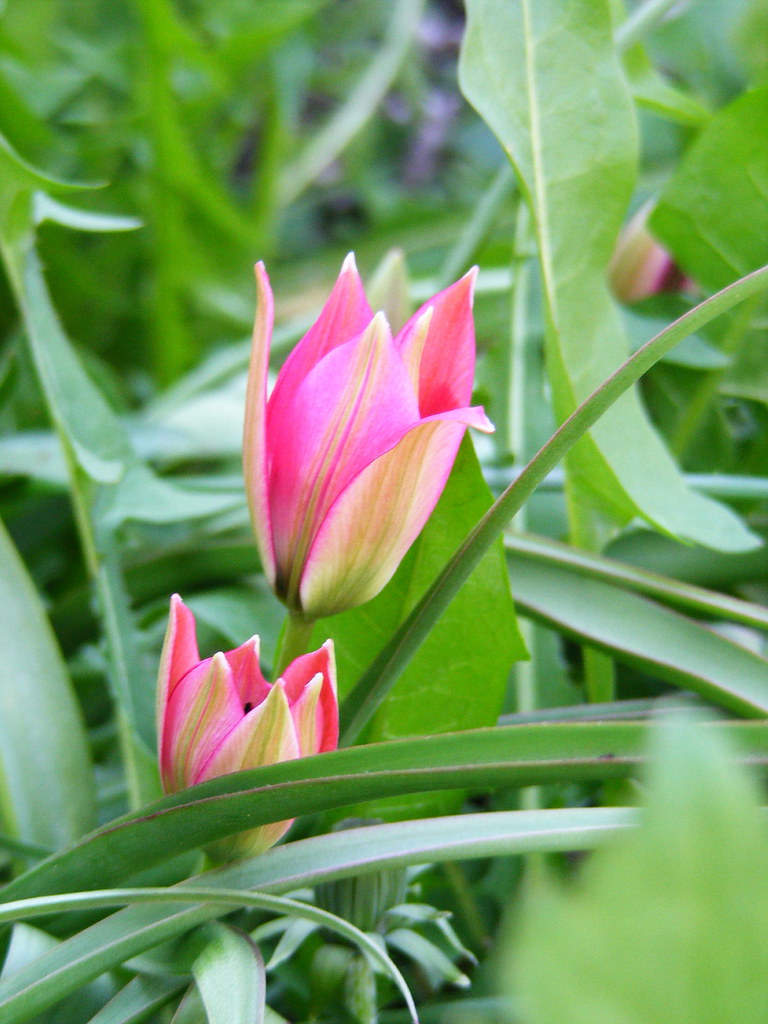 I'm a bit late posting these two shots, and have had them in draft form for a week or so, but now that they're almost done blooming, I figured now or never!
I'm a bit late posting these two shots, and have had them in draft form for a week or so, but now that they're almost done blooming, I figured now or never!
These dainty tulips are the other variety of 'Species Tulip' (Tulipa humilis) that I mentioned in a previous post earlier this year, and one from last year. As recently as a few weeks ago, I had hastily concluded that since they weren't up when the 'Persian Pearl' variety was blooming, that they had probably succumbed to the great tulip die off ... but as you can see here, I was oh sooo wrong. And glad to be wrong (for once!)
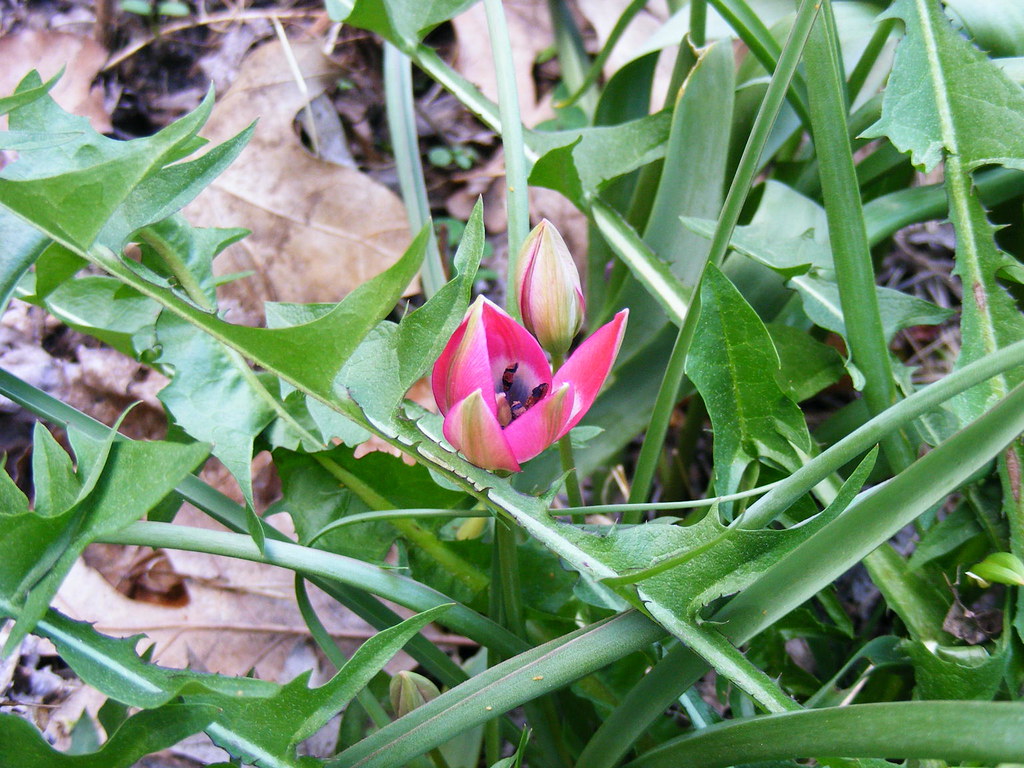 Fernymoss tried to reassure me that this variety, Little Beauty, was always much later than the other one, and that I should just quit worrying about it. Turns out he was right and shortly after 'Persian Pearl' finished blooming these little ones started showing up ... and contrary to the usual five we have (I got five of these as a freebie from Van Bourgondien), we now seem to have about 8 or 9 at present. So I guess they were just busy underground there for a while, preparing their much welcome and eventual arrival on the scene! At this point in the spring, these represent the last of the tulips to bloom and they'll only be around for maybe another few days or so before they die back until next year. Interestingly, the new ones that bloomed this year aren't quite true to the originals represented by these photos. 'Little Beauty,' as typically described, has deep pink to red outer petals, an inner band of white and a 'slate blue' center. The few variants that emerged this year followed the same basic pattern, however they have petals that have clearly morphed more into the orange range which really has brought an interesting contrast to the rest of their buddies. I suspect this is probably due to natural variations in the species, rather than being some odd cross that has occurred, though with the number of bees and other insects who visit them while they bloom, I suppose a cross could have happened somehow.
Fernymoss tried to reassure me that this variety, Little Beauty, was always much later than the other one, and that I should just quit worrying about it. Turns out he was right and shortly after 'Persian Pearl' finished blooming these little ones started showing up ... and contrary to the usual five we have (I got five of these as a freebie from Van Bourgondien), we now seem to have about 8 or 9 at present. So I guess they were just busy underground there for a while, preparing their much welcome and eventual arrival on the scene! At this point in the spring, these represent the last of the tulips to bloom and they'll only be around for maybe another few days or so before they die back until next year. Interestingly, the new ones that bloomed this year aren't quite true to the originals represented by these photos. 'Little Beauty,' as typically described, has deep pink to red outer petals, an inner band of white and a 'slate blue' center. The few variants that emerged this year followed the same basic pattern, however they have petals that have clearly morphed more into the orange range which really has brought an interesting contrast to the rest of their buddies. I suspect this is probably due to natural variations in the species, rather than being some odd cross that has occurred, though with the number of bees and other insects who visit them while they bloom, I suppose a cross could have happened somehow.
I'd encourage any of you tulip fans out there to consider planting some of the dwarf varieties (I certainly plan on getting a few more this fall!), because they offer all the beauty of their larger cousins, but can be grown comfortably in much smaller spaces (and only need to go down 4-5 inches rather than the regular 8 for larger tulips), they don't mind being crowded a bit, and as I mentioned in my previous post, they make excellent companions for other smaller spring bulbs such as Muscari and Hyacinths (just make sure you set any Hyacinths back a bit so that they don't overwhelm them). I often consult Paghat's Garden (see sidebar on resources) for excellent advice on growing certain species, and she mentions an interesting strategy that she has employed to great effect. She suggests planting them deep (at 8 inches), filling in a bit over the tulips and then planting very early snow crocus on another level above them. The crocus would then come up first, and then when they're done, the tulips can take over the show later in the spring ... I've seen others mention this technique but we've never really used it before, but I might be tempted to do just that with the next ones I plant. Again, I highly recommend these to any tulip fancier because they're just as beautiful, only smaller, and do have the advantage of sticking around in cool weather a bit longer than their bigger cousins the Darwins. And best of all, for such lovely tulips, they really aren't expensive at all, and if you shop around online at such places as Van Bourgondien, Park Seeds or McClure-Zimmerman, you can often find some really nice prices on these 'Species' tulips!
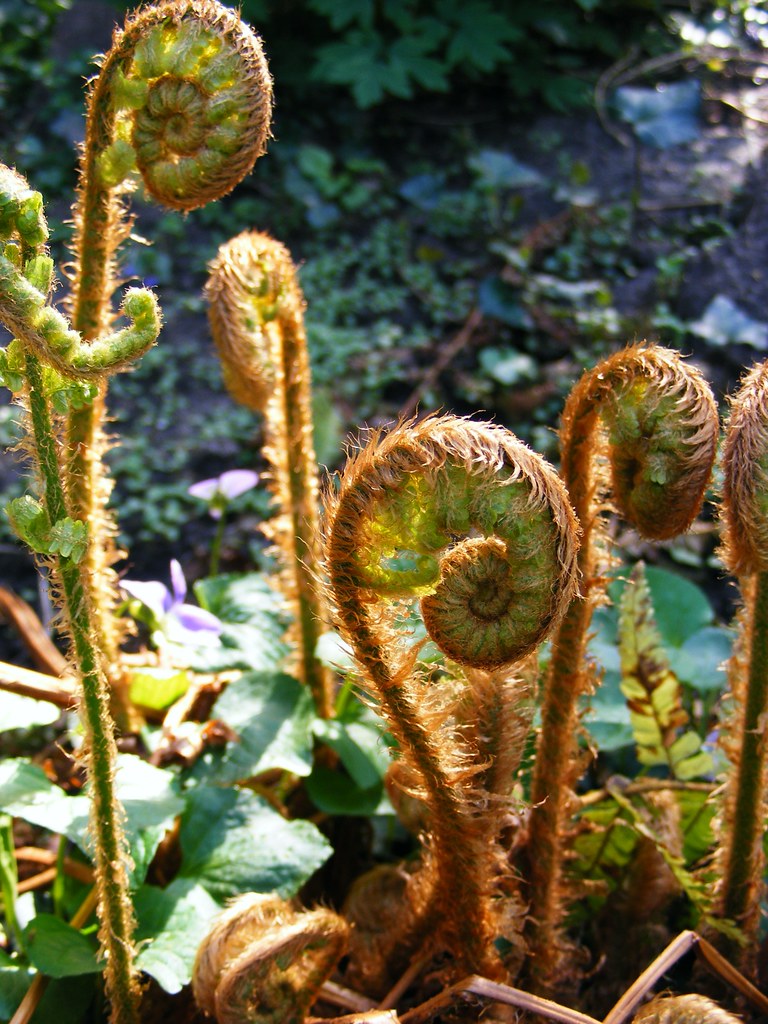 After all the color on display this week, how about capping it off with some contemplative greeny goodness? There's something inherently peaceful about ferns and moss that both of us connect with on a deep level ... they're not the stars of the Woodland Garden in the traditional "eye popping" sense, but they play a very important role in the overall composition of this part of the garden.
After all the color on display this week, how about capping it off with some contemplative greeny goodness? There's something inherently peaceful about ferns and moss that both of us connect with on a deep level ... they're not the stars of the Woodland Garden in the traditional "eye popping" sense, but they play a very important role in the overall composition of this part of the garden.
In fact, we tend to think of them as foundational features of the woodland personality here ... in spring and summer they provide an attractive backdrop to the more colorful plants around them while they're blooming, and when most things are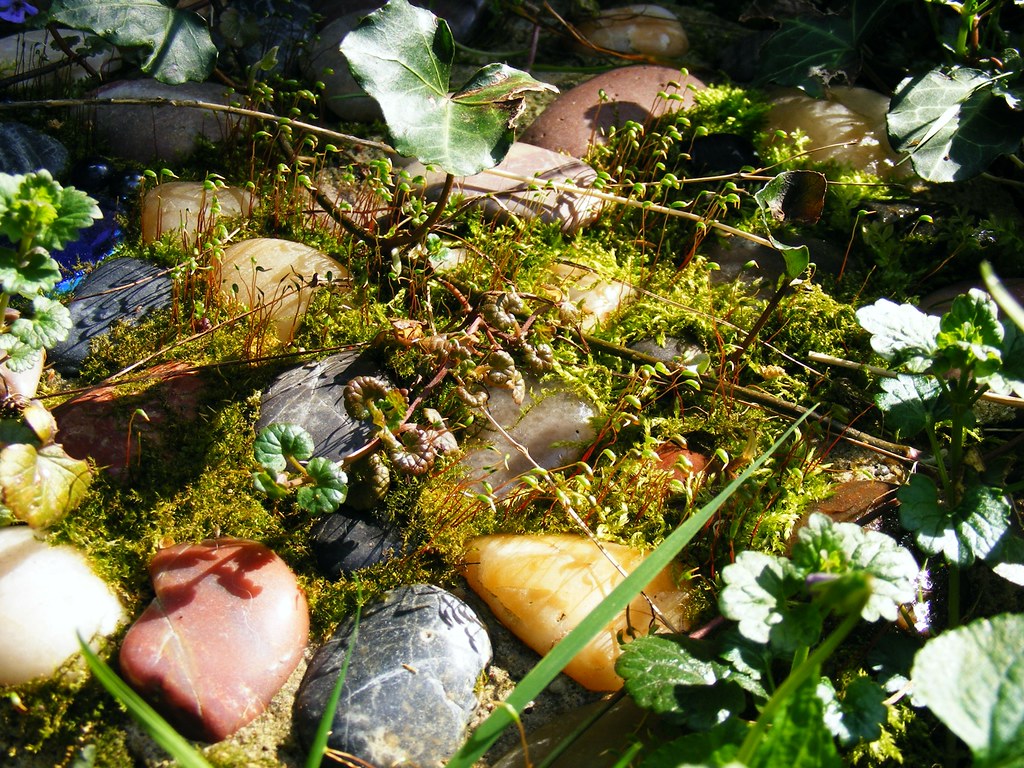 winding down, they still provide a lot of lush green interest in the fall, until well into early winter, sometimes staying green until they're completely covered by the snow.
winding down, they still provide a lot of lush green interest in the fall, until well into early winter, sometimes staying green until they're completely covered by the snow.
Fernymoss took these two shots on 6 May, 2008 ... the first are the unfurling fronds of one of our Leatherwood Ferns, one of the toughest ferns out there as far as we are concerned. These are the ones you sometimes see used in floral bouquets as "filler." (A shameful waste, I think!) The second shot is a close up of the moss growing on one of the stepping stones Fernymoss made a couple of years ago (I posted an earlier version of this a while back). We'll have to get busy and get some more shots of the other developing ferns soon ... the maidenhairs, ostrich plume and tassel ferns. There's still so much to get cleaned up and now with new plant purchases waiting to get in the ground, we feel terribly behind, just like we do each year, lol.
For maximum effect, please click for the larger image, where you can see a whole lot more detail than you can in these reduced versions. (Firefox users, right click and choose "view image" or "open in new tab" option. Believe me, it will be worth your while!)
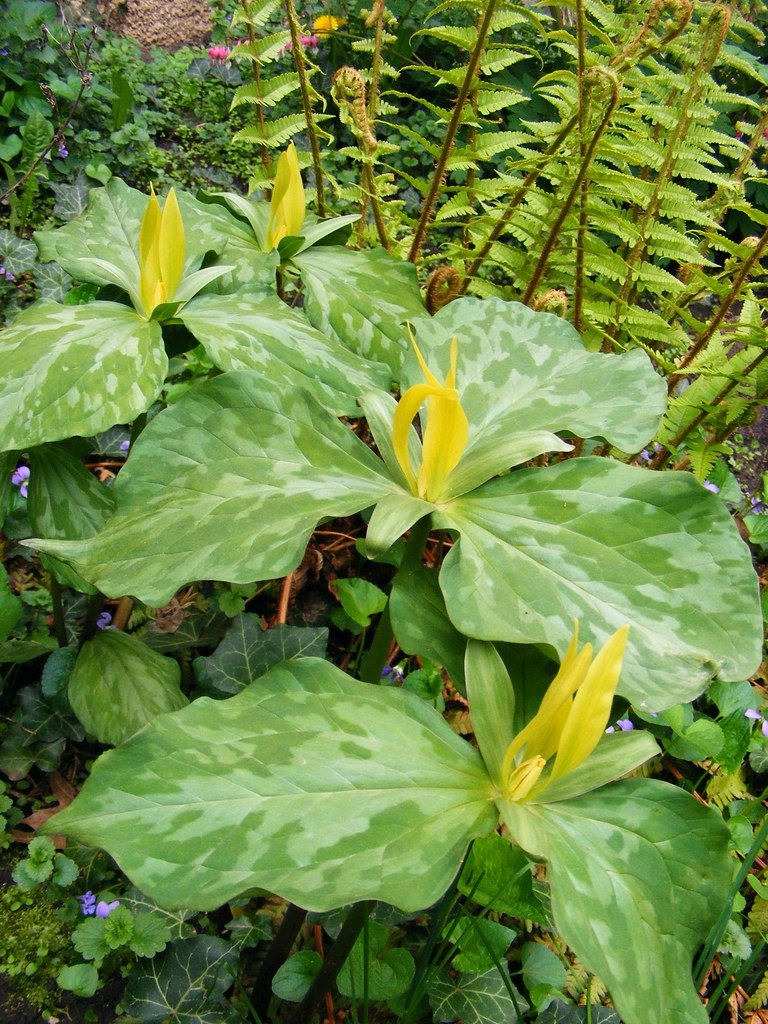 Trillium is a plant we only acquired a mere two years ago, when we found out that we had been under the mistaken impression that they were extremely rare ... Then we saw them for sale at one of our favorite early spring garden haunts and we snapped all two of them up without even thinking.
Trillium is a plant we only acquired a mere two years ago, when we found out that we had been under the mistaken impression that they were extremely rare ... Then we saw them for sale at one of our favorite early spring garden haunts and we snapped all two of them up without even thinking.
So out they went amongst the other shade lovers in our Woodland Garden, nestled among the maidenhair ferns and leatherwoods, not far from the toad lilies. Last year we were fortunate enough to find one more (same place) along with a tiny jack in the pulpit, which is now blooming not far from this clump. Initially, we fretted quite a bit at how they'd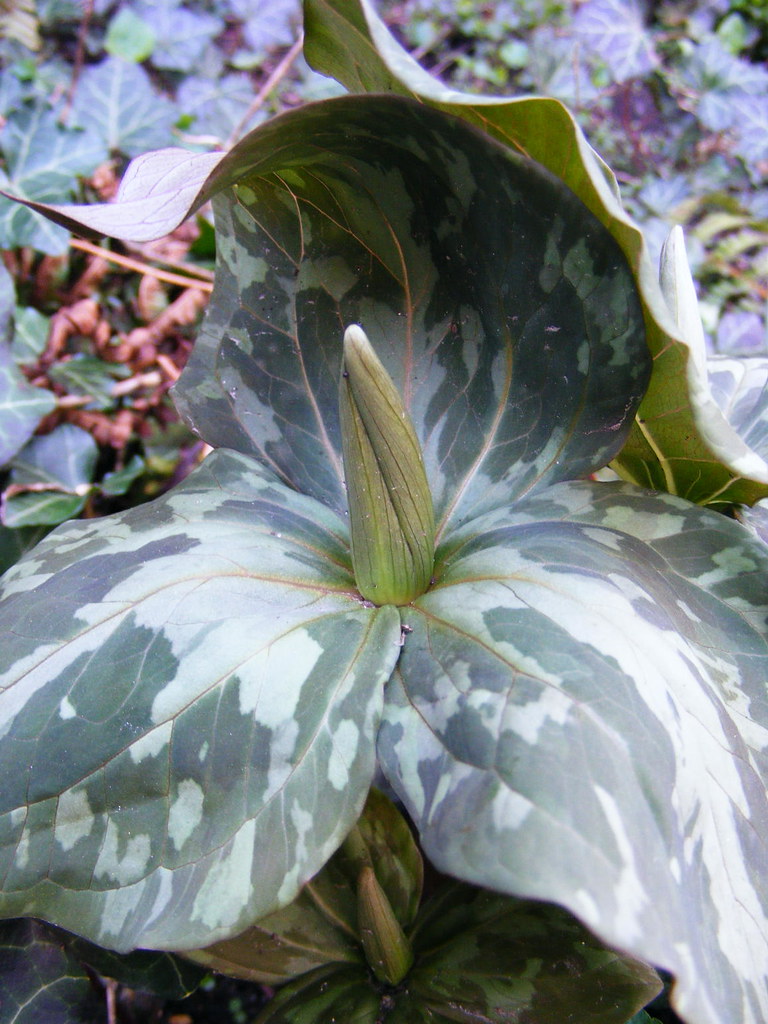 do in our woodland planting, but the first year they didn't bloom, but held their own till the hotter months of the summer before disappearing. Last year, even with all the horrible spring cold, they came back vigorously and rewarded us with blooms!
do in our woodland planting, but the first year they didn't bloom, but held their own till the hotter months of the summer before disappearing. Last year, even with all the horrible spring cold, they came back vigorously and rewarded us with blooms!
This year we've apparently hit the jackpot ... because not only did the original ones re-emerge happy as can be, but they brought a couple of new ones along to join the family! Now we're not fretting anymore, just thrilled and encouraged by how well they've taken up residence with some of their ferny neighbors, toad lilies and hellebores ... so we're hopeful that they'll keep multiplying in future years and develop a nice drift of them eventually, much as I imagine they do in the wild.
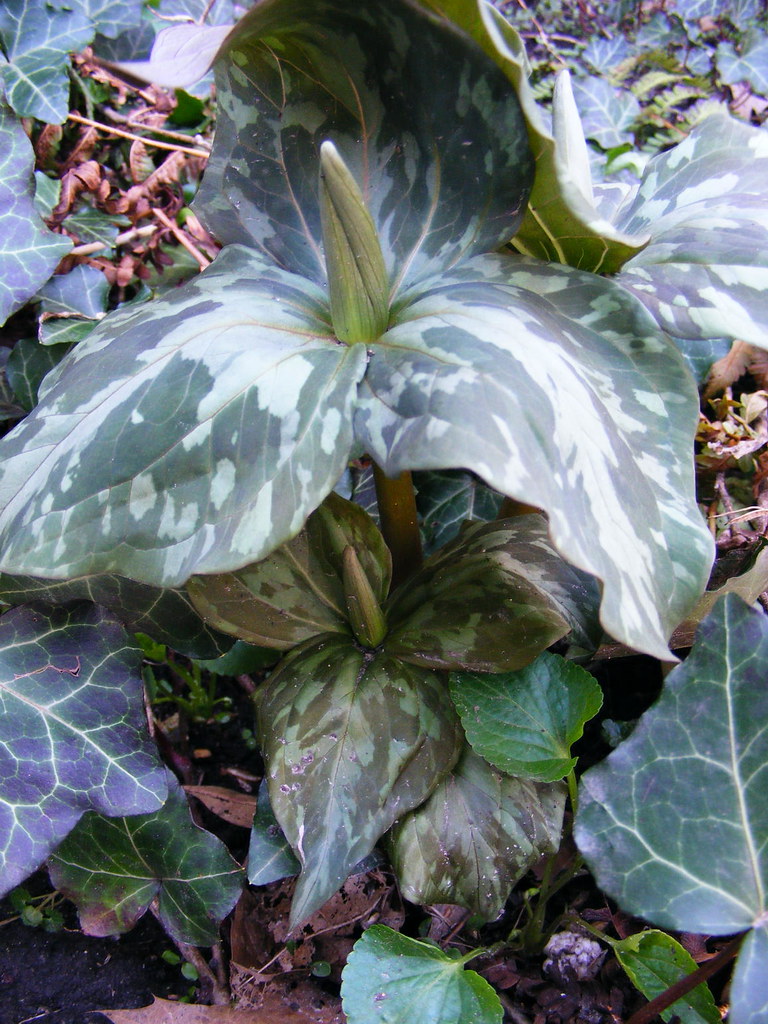 I'm still learning the basics about Trillium though I do know that there are 40-50 species, most of which are North American natives, and that in most states where they grow in the wild it's illegal to pick or take them from the wild. That's a good thing, because a Trillium once picked is basically a dead Trillium, and if the plant does manage to survive such an affront, it may take years to recover. Fortunately though, nurseries are now propagating them from seed and offering them to the public, which thankfully is how we got ours. I've read that nursery bred specimens are notoriously unreliable as to what species you're actually getting ... at this point we don't care much about that, because we're just contented to have a happy grouping growing for us. We'd like to get one of the Trillium erectum or 'Red Wake Robin' species but haven't found one yet. The red one is (aside from the color) of special interest to us because it's one of the Pedeceled Trilliums, meaning that the flower appears on a slim stem above the leaves. Ours is Trillium luteum as far as I can determine, one of the other group of bloomers known as Sessile Trilliums because their flowers emerge directly from the center of the plant. One of the things we find the coolest about this Sessile species is that it emerges practically ready to bloom ... once the plant has unfurled its leaves the bud is clearly prominent and takes a couple of weeks to open fully. The differences in lighting in these shots (one sunny day, one very cloudy) really show how the light can affect their appearance ... the first one was the very cloudy day late in the afternoon when there was a tiny bit of sun trying to break through, whereas the other two were taken earlier on a fairly sunny day ....
I'm still learning the basics about Trillium though I do know that there are 40-50 species, most of which are North American natives, and that in most states where they grow in the wild it's illegal to pick or take them from the wild. That's a good thing, because a Trillium once picked is basically a dead Trillium, and if the plant does manage to survive such an affront, it may take years to recover. Fortunately though, nurseries are now propagating them from seed and offering them to the public, which thankfully is how we got ours. I've read that nursery bred specimens are notoriously unreliable as to what species you're actually getting ... at this point we don't care much about that, because we're just contented to have a happy grouping growing for us. We'd like to get one of the Trillium erectum or 'Red Wake Robin' species but haven't found one yet. The red one is (aside from the color) of special interest to us because it's one of the Pedeceled Trilliums, meaning that the flower appears on a slim stem above the leaves. Ours is Trillium luteum as far as I can determine, one of the other group of bloomers known as Sessile Trilliums because their flowers emerge directly from the center of the plant. One of the things we find the coolest about this Sessile species is that it emerges practically ready to bloom ... once the plant has unfurled its leaves the bud is clearly prominent and takes a couple of weeks to open fully. The differences in lighting in these shots (one sunny day, one very cloudy) really show how the light can affect their appearance ... the first one was the very cloudy day late in the afternoon when there was a tiny bit of sun trying to break through, whereas the other two were taken earlier on a fairly sunny day ....
One more thing (so Olivia doesn't have to remind me!) ... The Great White Trillium is the Official State Flower of the Province of Ontario ... lucky Canadians (once again)!
Photos taken by Fernymoss on 26 April, (shots two and three) and 13 May, 2008 (first shot).
UPDATE: It's a good thing my credit cards are downstairs right now, because I did a bit more clicking around and this company, American Meadows, has the 'Red Wake Robin' for sale! Though I expect we'll probably be ordering some soon ....!
 The Primroses are really hitting their stride right about now, and with the still fairly cool weather and nights, they should continue to bloom for a few more weeks at least. I think we've finally seen the full range of the colors we currently have, so when I'm looking for more to plant, I'll know what others I want to include. I think we have red pretty well covered at this point, don't you think? I already think I want more yellows and some of the lovely blues as well, though I wouldn't turn down another nice mix of 5 or 6 like this either!
The Primroses are really hitting their stride right about now, and with the still fairly cool weather and nights, they should continue to bloom for a few more weeks at least. I think we've finally seen the full range of the colors we currently have, so when I'm looking for more to plant, I'll know what others I want to include. I think we have red pretty well covered at this point, don't you think? I already think I want more yellows and some of the lovely blues as well, though I wouldn't turn down another nice mix of 5 or 6 like this either!
I'm so pleased with how they have settled in and started to multiply in a mere three years, so I can't quite resist the urge to just fill this small bed with them and just add a few annuals for summer and call it quits. There's already some Meadow Sage, Lavender, Bee Balm in this small bed, and we grow morning glories on a trellis there as well, so there's a lot going on in the summer!
I guess once you've tasted success with these little beauties, it turns into a mild obsession ... kind of like what happened with me and Toad Lilies!
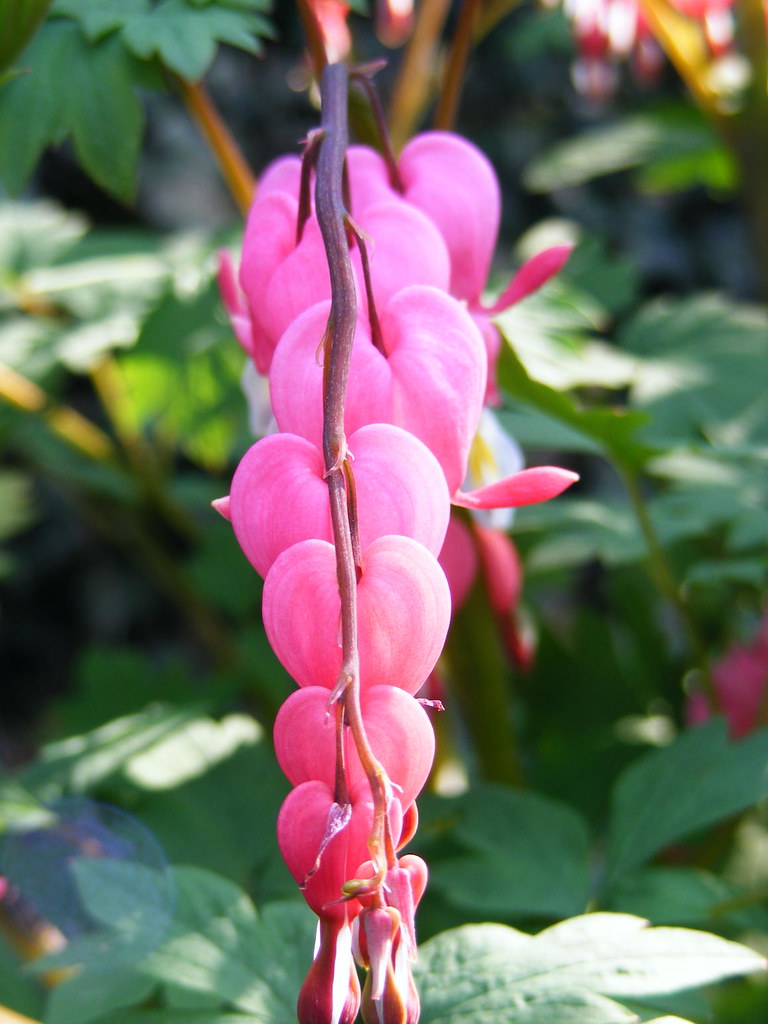 These 'Old Fashioned Bleeding Heart' (Dicentra spectabilis) have quite happily established themselves on the north, Woodland side of the house and represent some of the very first plants we put in that particular area of the garden. (In 1999, hard to believe!) They've since been joined by a lot of other shade lovers, namely ferns of all sorts, Ligularia, Polygonatum (Solomon's Seal), Hellebores, Lungwort and a few others, so this particular area is pretty full, as you can see in the second shot! And if you look way back in the photo, you can see the peonies already up about 3 ft and putting on buds (just in front of the fence to the right ... click for full sized image).
These 'Old Fashioned Bleeding Heart' (Dicentra spectabilis) have quite happily established themselves on the north, Woodland side of the house and represent some of the very first plants we put in that particular area of the garden. (In 1999, hard to believe!) They've since been joined by a lot of other shade lovers, namely ferns of all sorts, Ligularia, Polygonatum (Solomon's Seal), Hellebores, Lungwort and a few others, so this particular area is pretty full, as you can see in the second shot! And if you look way back in the photo, you can see the peonies already up about 3 ft and putting on buds (just in front of the fence to the right ... click for full sized image).
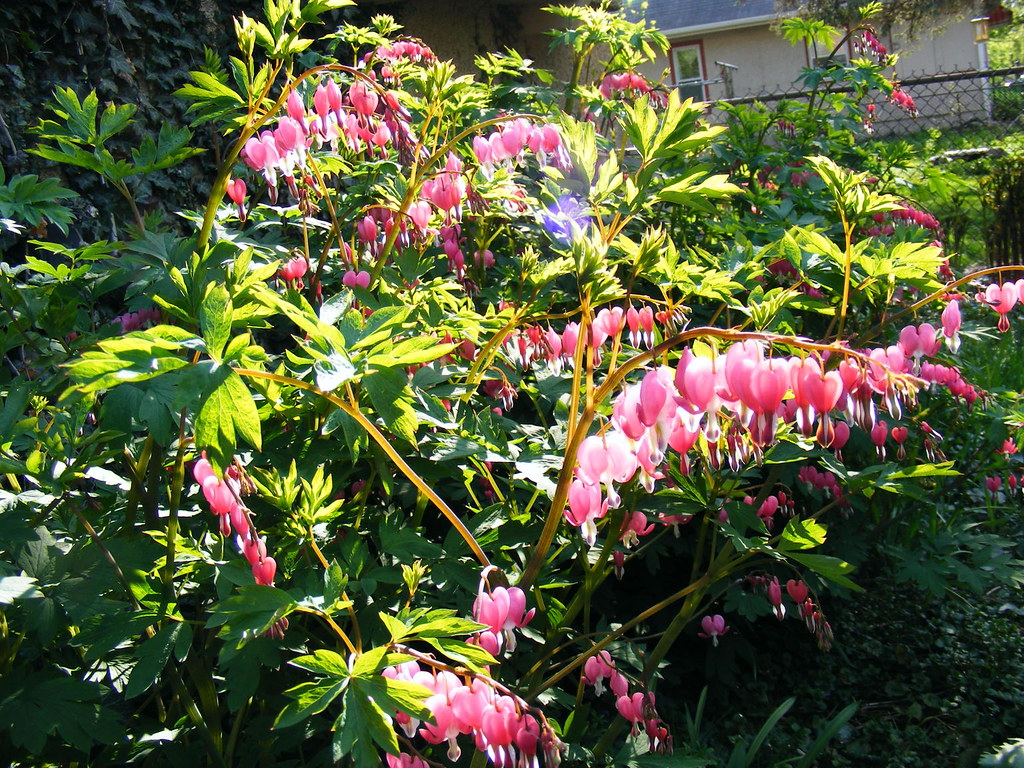 People ask us every year what we do to make these grow so huge, but that's always been entirely up to them! By a happy confluence of circumstances, of light and consistently moist, well drained soil they have almost become garden punks, spreading out a bit further every year, and we often have to dig new plants (from seeds and/or natural spreading) to keep them from taking over entirely. So usually a few people are the lucky recipients of the unwanted offspring each year ... well except for last year when they too were severely zapped by that cold spell. Well, they're back with a vengeance this year and have just flown out of the ground the past couple of weeks, hardly waiting for the leaves to open fully before they started blooming. There is a white one that hasn't been doing as well so far this year, but I'm pretty confident that it will eventually hit its stride soon, and I'll be sure to post it here. But in the interim, just enjoy these first few shots ...
People ask us every year what we do to make these grow so huge, but that's always been entirely up to them! By a happy confluence of circumstances, of light and consistently moist, well drained soil they have almost become garden punks, spreading out a bit further every year, and we often have to dig new plants (from seeds and/or natural spreading) to keep them from taking over entirely. So usually a few people are the lucky recipients of the unwanted offspring each year ... well except for last year when they too were severely zapped by that cold spell. Well, they're back with a vengeance this year and have just flown out of the ground the past couple of weeks, hardly waiting for the leaves to open fully before they started blooming. There is a white one that hasn't been doing as well so far this year, but I'm pretty confident that it will eventually hit its stride soon, and I'll be sure to post it here. But in the interim, just enjoy these first few shots ...
Photos taken by Fernymoss on 6 May, 2008.

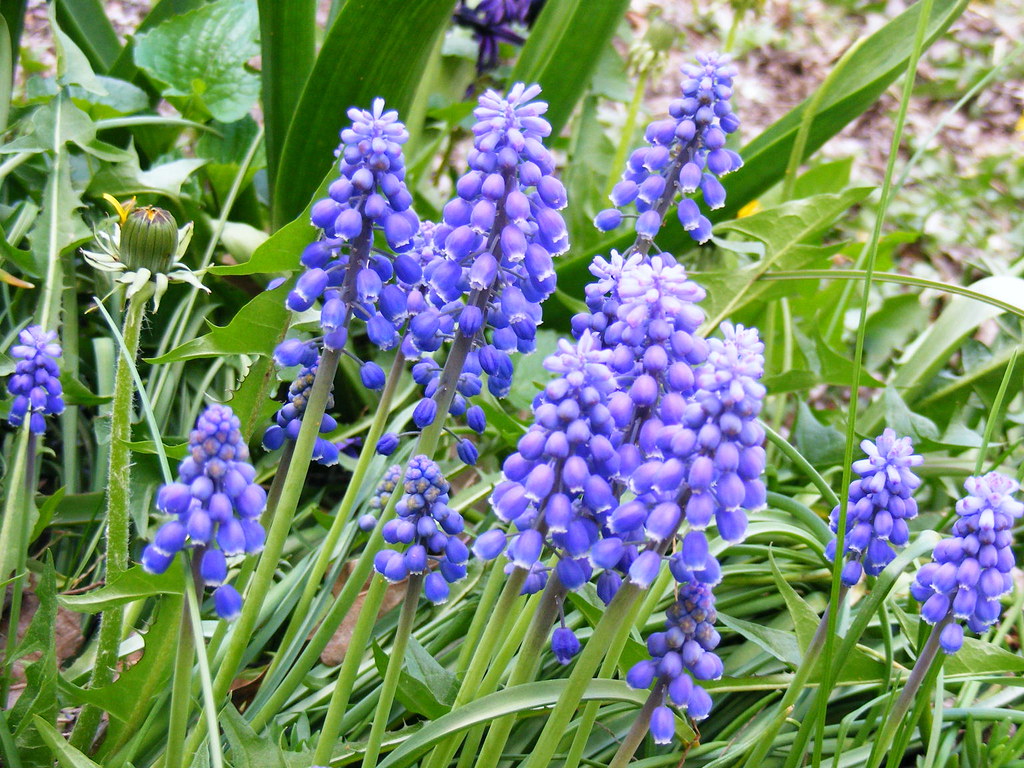 Here's another early spring favorite in many gardens, the common "Grape Hyacinth" (Muscari armeniacum). They look (and grow) great in many different areas of the garden, but really excel when planted in a mass as a companion bulb to more fire colored Tulips ... in fact, until this year we had a couple such plantings, but as the tulips went, so did many of the Muscari with them, so even though we still have a lot of them around and naturalizing, they're not as numerous as they once were.
Here's another early spring favorite in many gardens, the common "Grape Hyacinth" (Muscari armeniacum). They look (and grow) great in many different areas of the garden, but really excel when planted in a mass as a companion bulb to more fire colored Tulips ... in fact, until this year we had a couple such plantings, but as the tulips went, so did many of the Muscari with them, so even though we still have a lot of them around and naturalizing, they're not as numerous as they once were.
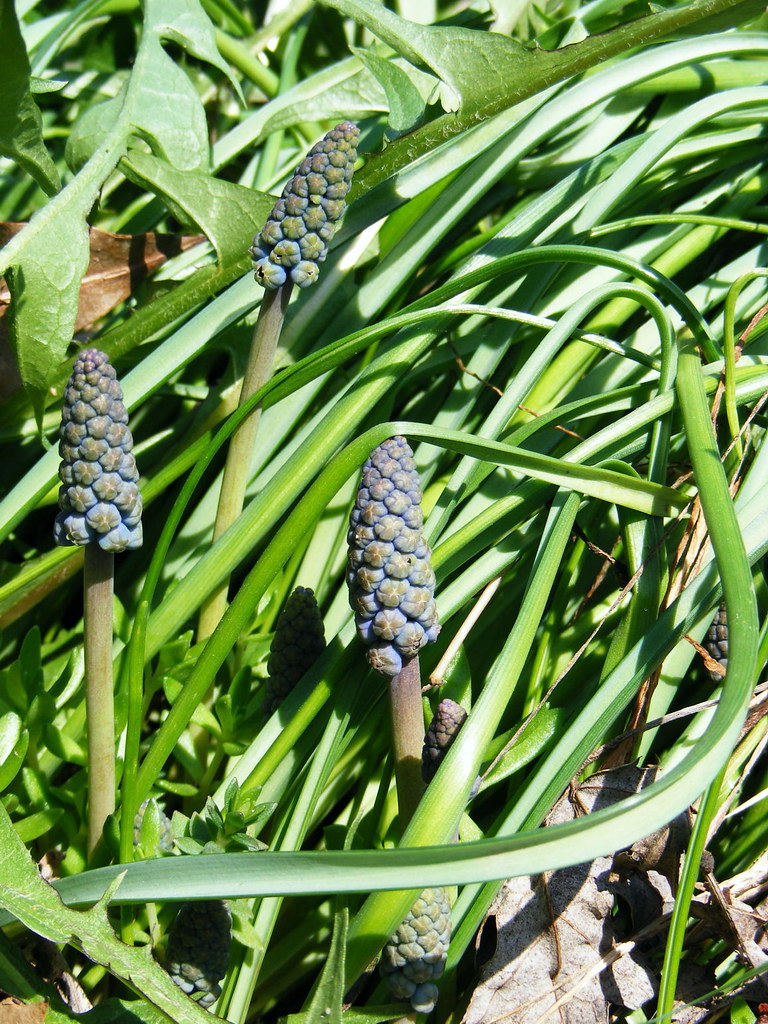 And for naturalizing purposes in a bulb garden (or even your lawn or flower beds), they're hard to beat. They're quick about colonizing a small area for themselves in just a matter of two to three years, which for naturalizing bulbs represents a really nice feature of the Muscari. They are now sold in a wide range of colors from the standard blue/purple to white and even some newer varieties that have been bred into bicolors, though I have to say the latter aren't quite my cup of tea because they just lack the natural look of the basic species. Exceptionally hard, (from zones 4-8), once established successfully, they're pretty tenacious little guys as the first picture shows ... this particular specimen was probably one of the very first bulbs we planted originally back in 1999. When we built the boulder bed in 2003, a lot of the bulbs we had along the sidewalk were dislodged or buried completely, and this is one of two who faithfully emerge from the rocks each spring to grace the gap for the length of their bloom period. Ever since we first noticed them, we've been really pleased at how intent they are on delivering a colorful performance each spring. They're especially attractive planted in masses, as the second and third shots demonstrate ... and there's an amusing (at least for me) tale behind how they ended up planted in this particular grouping. After the first exhausting round of planting bulbs in 1999, I happened to find about six bulbs on the porch that we had forgotten to plant. Even though it was well after frost and there was a bit of snow on the ground, I figured well, if I don't plant them they'll rot over the winter, so I might as well just stick them in somewhere and see what happens ... so out I went into the snow with a trowel and dug a hole for them very near the sidewalk where they have continued to grow ever since ... They look pretty cool for an afterthought planting, don't you think?
And for naturalizing purposes in a bulb garden (or even your lawn or flower beds), they're hard to beat. They're quick about colonizing a small area for themselves in just a matter of two to three years, which for naturalizing bulbs represents a really nice feature of the Muscari. They are now sold in a wide range of colors from the standard blue/purple to white and even some newer varieties that have been bred into bicolors, though I have to say the latter aren't quite my cup of tea because they just lack the natural look of the basic species. Exceptionally hard, (from zones 4-8), once established successfully, they're pretty tenacious little guys as the first picture shows ... this particular specimen was probably one of the very first bulbs we planted originally back in 1999. When we built the boulder bed in 2003, a lot of the bulbs we had along the sidewalk were dislodged or buried completely, and this is one of two who faithfully emerge from the rocks each spring to grace the gap for the length of their bloom period. Ever since we first noticed them, we've been really pleased at how intent they are on delivering a colorful performance each spring. They're especially attractive planted in masses, as the second and third shots demonstrate ... and there's an amusing (at least for me) tale behind how they ended up planted in this particular grouping. After the first exhausting round of planting bulbs in 1999, I happened to find about six bulbs on the porch that we had forgotten to plant. Even though it was well after frost and there was a bit of snow on the ground, I figured well, if I don't plant them they'll rot over the winter, so I might as well just stick them in somewhere and see what happens ... so out I went into the snow with a trowel and dug a hole for them very near the sidewalk where they have continued to grow ever since ... They look pretty cool for an afterthought planting, don't you think?
Muscari armeniacum in various positions in and around the front boulder bed. The first two shots were taken on 5/06/08 and the third taken on 4/26/08 when they had just emerged and taking on color. Photos taken by Fernymoss, with the S700 of course ...
 You may well recognize the second shot in this post, because a slightly different version appeared on Urban Oasis just a few days ago. In fact, both these shots (from 5/06) have been "tinkered" with using photo editing software. They're my first experiments with the new software I was finally forced into downloading last night ... see, I got a trial period copy of Paint Shop Pro with my new computer last fall, and when it expired, there went a lot of the editing functions I used a lot.
You may well recognize the second shot in this post, because a slightly different version appeared on Urban Oasis just a few days ago. In fact, both these shots (from 5/06) have been "tinkered" with using photo editing software. They're my first experiments with the new software I was finally forced into downloading last night ... see, I got a trial period copy of Paint Shop Pro with my new computer last fall, and when it expired, there went a lot of the editing functions I used a lot.
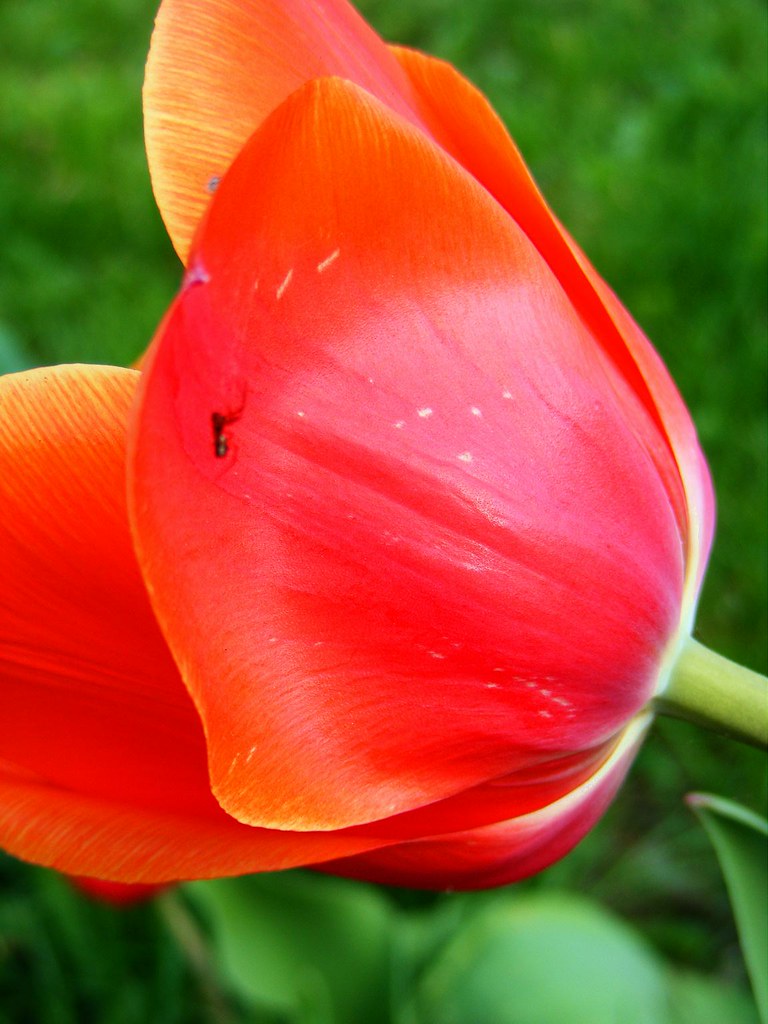 So I checked out their upgrade offer, which is now called Corel Photo Album 6 (apparently PSP is no more?). I took a quick spin with some of the features on their website and I quickly concluded for $39 I could do much worse in terms of the features that really matter to me in working with my photos. So out came the credit card and I set down to work ... and work is just what it was in terms of a download! In one of the more complicated downloads I've done in a while, I had to first register an account at Corel, then choose the upgrade download, provide the usual purchase information and then wait for an email with further instructions on how to proceed ... about 15 minutes later the email arrived with my serial number/activation code in it. Then I had to go to another page for detailed step by step instructions on how to download and install it. Then I went to the next step, which involved downloading and installing three installation files ... once that was done, I was told that I had only downloaded a trial version with some features disabled, but in order to "activate it," I had to go to another web page (link provided), enter my activation code and submit it, which took all of about 30 seconds once I clicked the 'continue' button. Then I was informed that now I should launch the program, and it would prompt me (yet again) for the activation code so that it could verify with their website that it was a legit copy. Whew, once accomplished, I was finally able to begin using it! Now I'm sure this was all an anti-piracy method, and I really don't have much of a problem with most of those schemes, but jeez folks, there's got to be a less complicated way to go about it!
So I checked out their upgrade offer, which is now called Corel Photo Album 6 (apparently PSP is no more?). I took a quick spin with some of the features on their website and I quickly concluded for $39 I could do much worse in terms of the features that really matter to me in working with my photos. So out came the credit card and I set down to work ... and work is just what it was in terms of a download! In one of the more complicated downloads I've done in a while, I had to first register an account at Corel, then choose the upgrade download, provide the usual purchase information and then wait for an email with further instructions on how to proceed ... about 15 minutes later the email arrived with my serial number/activation code in it. Then I had to go to another page for detailed step by step instructions on how to download and install it. Then I went to the next step, which involved downloading and installing three installation files ... once that was done, I was told that I had only downloaded a trial version with some features disabled, but in order to "activate it," I had to go to another web page (link provided), enter my activation code and submit it, which took all of about 30 seconds once I clicked the 'continue' button. Then I was informed that now I should launch the program, and it would prompt me (yet again) for the activation code so that it could verify with their website that it was a legit copy. Whew, once accomplished, I was finally able to begin using it! Now I'm sure this was all an anti-piracy method, and I really don't have much of a problem with most of those schemes, but jeez folks, there's got to be a less complicated way to go about it!
After playing with it a bit and getting all my photos catalogued, I discovered the enhancement editing features, which include adjusting for exposure, color, brightness, contrast and other useful functions. It even let me instantly compare what I was doing with the original, which is a nice touch I thought. So ... these are the first two crude experiments that came out of that little session with the new software ... I thought they turned out fairly well, considering I really didn't know entirely what I was doing, but I was happy with the results. Sure, it's no Photoshop, but honestly, that program is too expensive and still way beyond my basic editing skill set. I need something that I can use quickly to perform basic editing (resizing, cropping, etc.) so I can get them uploaded. Though the interface is a bit different from what I was used to in PSP, in terms of its intuitive feel, it's very similar ... so far I'm liking it! And when I can get my skill set upgraded, I'll probably try to do more complicated stuff in GIMP, once I can get used to and figure out how that beast operates ... the little I've done with it so far was very confusing, though in the open source world of software, it's reputed to be on the par with Photoshop. The worst thing for me in the trial run was the fact that you have to have multiple windows open to do anything and have to switch back and forth between them to accomplish even a basic task. Just resizing a photo was too much effort than what I was going to endure at that frustrating point, so I put it aside for a while. Fernymoss has used it for several years and likes it, and says that it's very powerful once you learn it. At this point though, that's for another day! He took a look at the new program I downloaded last night and thought it was pretty good overall. He was especially impressed with how easy it is to perform those enhancement functions I was talking about. Now, I'll just say that 99+% (at this point) of the photos I use here are basically untouched except for resizing and some cropping in certain cases. Call me a curmudgeon, but I still have a fair amount of resistance to drastically altered images for the most part, so if/when I do do something to a photo, I'll be sure to make a note of that. So, the majority of the photos you see here are reproduced au naturel.
 Indeed! Since my childhood I've loved the spring wood violets and I still do, but with a sometimes less favorable eye than when I was younger. This somewhat endemic species, Viola sororia, as most midwesterners know, can be an outright rogue in the lawn and gardens, where it multiplies so quickly that it can threaten overtaking some of our more desirable perennials in the border. But honestly, isn't it hard to resist any of the Viola species? At least it is for me ... so we've come to a basically tolerant compromise with the hundreds of Violets that spread through our gardening areas and lawn. We can't eliminate them, they're so pretty we feel guilty about digging them and sending them to the compost, but where they intrude too far, we have no compunction about discarding them ... it's not like we'll ever go lacking in spring violets! And I should say that when we go at them in one area and dig up a lot of them, we usually take them to the back yard and plant them around the base of the old maple out there ... not all of them make it, due to the heavy dog traffic, but we're appreciative of those who do. After all, no matter how much of a pest they can become, they are a native species that deserves some respect!
Indeed! Since my childhood I've loved the spring wood violets and I still do, but with a sometimes less favorable eye than when I was younger. This somewhat endemic species, Viola sororia, as most midwesterners know, can be an outright rogue in the lawn and gardens, where it multiplies so quickly that it can threaten overtaking some of our more desirable perennials in the border. But honestly, isn't it hard to resist any of the Viola species? At least it is for me ... so we've come to a basically tolerant compromise with the hundreds of Violets that spread through our gardening areas and lawn. We can't eliminate them, they're so pretty we feel guilty about digging them and sending them to the compost, but where they intrude too far, we have no compunction about discarding them ... it's not like we'll ever go lacking in spring violets! And I should say that when we go at them in one area and dig up a lot of them, we usually take them to the back yard and plant them around the base of the old maple out there ... not all of them make it, due to the heavy dog traffic, but we're appreciative of those who do. After all, no matter how much of a pest they can become, they are a native species that deserves some respect!
As I was writing this post, I thought about where you find them in urban areas ... and I came to a not entirely empirical conclusion that one finds them mostly in older, established areas these days, and not so very much in the newly developed sub-divisions ... to my mind that's a sad observation. I've never been much a fan of the seemingly inevitable, overly developed suburban building, and it just confirms why I feel so much more comfortable in an old house in an older part of the city. Yes, we have our common weedy herbaceous species in abundance ("Creeping Charlie" aka "Ground Ivy," purple and white clover, garden nightshade vine --you know, the kind of vine that produces red berries your mother always told you never to eat?-- not to mention others), but I like to think of them as parts of a more complete ecosystem that has established itself over many years. As inconvenient as they may seem at times, they're ultimately (at least usually! I do not have any fondness for poison ivy!) beneficial to the soil and the garden at large. Besides, how can you resist them? I can't, so we just live with them peacefully now.
Today was pretty rainy off and on, so our plans to get more clean up done in the beds were postponed (again) so we went plant shopping instead. We came home with some nice finds (though some things we were looking for weren't in yet, alas), including a new hibiscus variety Luna Red, three new peonies (they were on sale for a great price of $9.95!) called Paeonia lactiflora 'Karl Rosenfield' that looks very promising, and the plants are large and healthy ... some more Artemisia "Silver Mound" (to replace the ones who didn't make it), and a fancy Martha Washington type geranium, a few more Delphinium 'Blue Elf' since it seems the ones I planted last year didn't make it, so I'll give them one more try ... we even got some Petunias this year (mostly for the color and the hummingbird potential)! Unfortunately we didn't find (at this particular place, which we like a lot) the Trilliums or Jack in the Pulpits we really wanted, but we did put in a request that they order them, so we'll see if they come through. Anyway, it's enough to keep us busy planting for the next week or so ... with any luck they'll come through and we can add those as well. At this point, it feels like we're so behind this year, but given the winter we had, I guess that many are feeling this way ... so much to do, so little time! The perpetual gardener's conundrum ... but we'll get there yet soon, I hope!

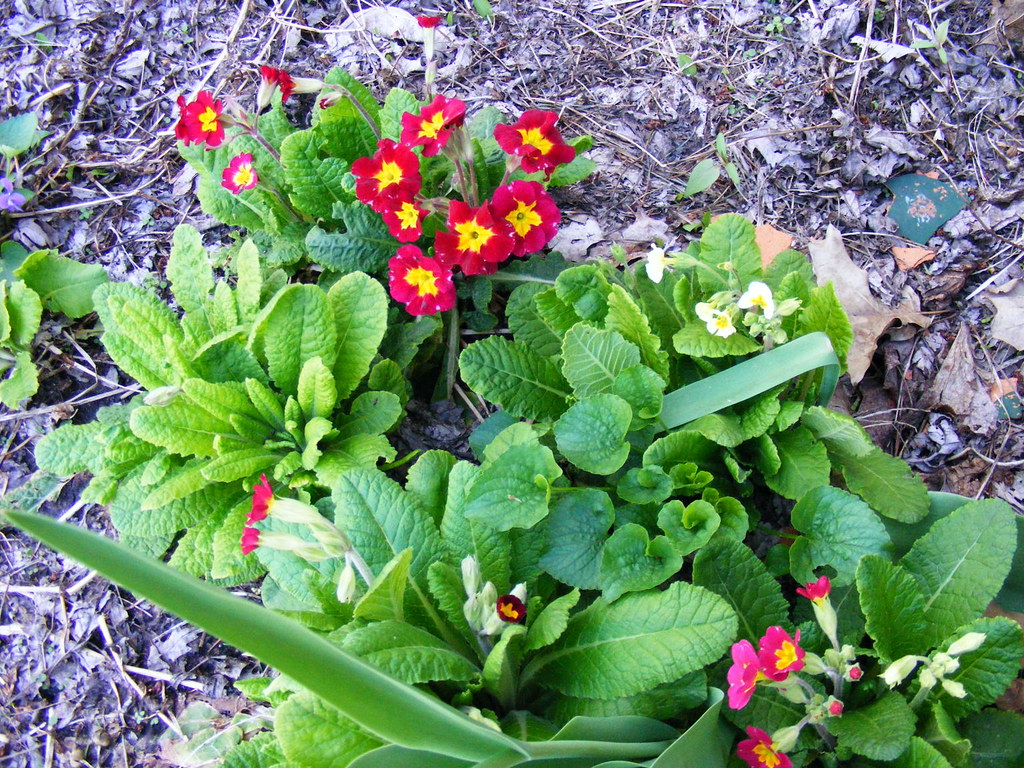 I've definitely become a fan of Primula polyanthus because it's truly proven itself to be quite adaptive to our notably fickle springs the past couple of years. The red one in the second shot was the first to bloom this year, though the others have been joining the show in rapid succession. I've been trying for years to get a nice little mound of these brilliantly coloured flowers going in various spots, and it seems like I finally hit the magic spot when I planted these in the little bed to the left of our front steps. They're protected by the porch overhang from the blazing sun of summer, which along with dry conditions and heat are the two mortal enemies of Primulas. Ever since I planted my first five here I've been pretty compulsive about making sure they get at least some water every day throughout the season and it seems to be working so far.
I've definitely become a fan of Primula polyanthus because it's truly proven itself to be quite adaptive to our notably fickle springs the past couple of years. The red one in the second shot was the first to bloom this year, though the others have been joining the show in rapid succession. I've been trying for years to get a nice little mound of these brilliantly coloured flowers going in various spots, and it seems like I finally hit the magic spot when I planted these in the little bed to the left of our front steps. They're protected by the porch overhang from the blazing sun of summer, which along with dry conditions and heat are the two mortal enemies of Primulas. Ever since I planted my first five here I've been pretty compulsive about making sure they get at least some water every day throughout the season and it seems to be working so far.
How am I sure they're happy now (despite the blooms)? Well, I mentioned that I started with five, but if you look closely, you'll see at least seven in this shot, and there is at least one more that was out of field of the lens here. In fact, there may even be nine at this point as I think I saw another small one out there the other day ... after they've finished their first blush of flowers, I plan to give them a good feeding, keep watering frequently and hope that they rest a bit, grow some more and perhaps bloom again this year. If not, as long as I can keep them happy and well watered over the summer, they should be back again next year bigger and better than ever. My dream would be to have them colonize this entire bed in time ... wouldn't that be stunning? And if I happen to find any more nice plants (at a good price) this spring, I'll snap them up and put them in with the others.
Ever since I first encountered Primulas planted in huge masses in France many moons ago (in 1978 to be exact), I've been in love with them and am of the mind that you can never have enough!
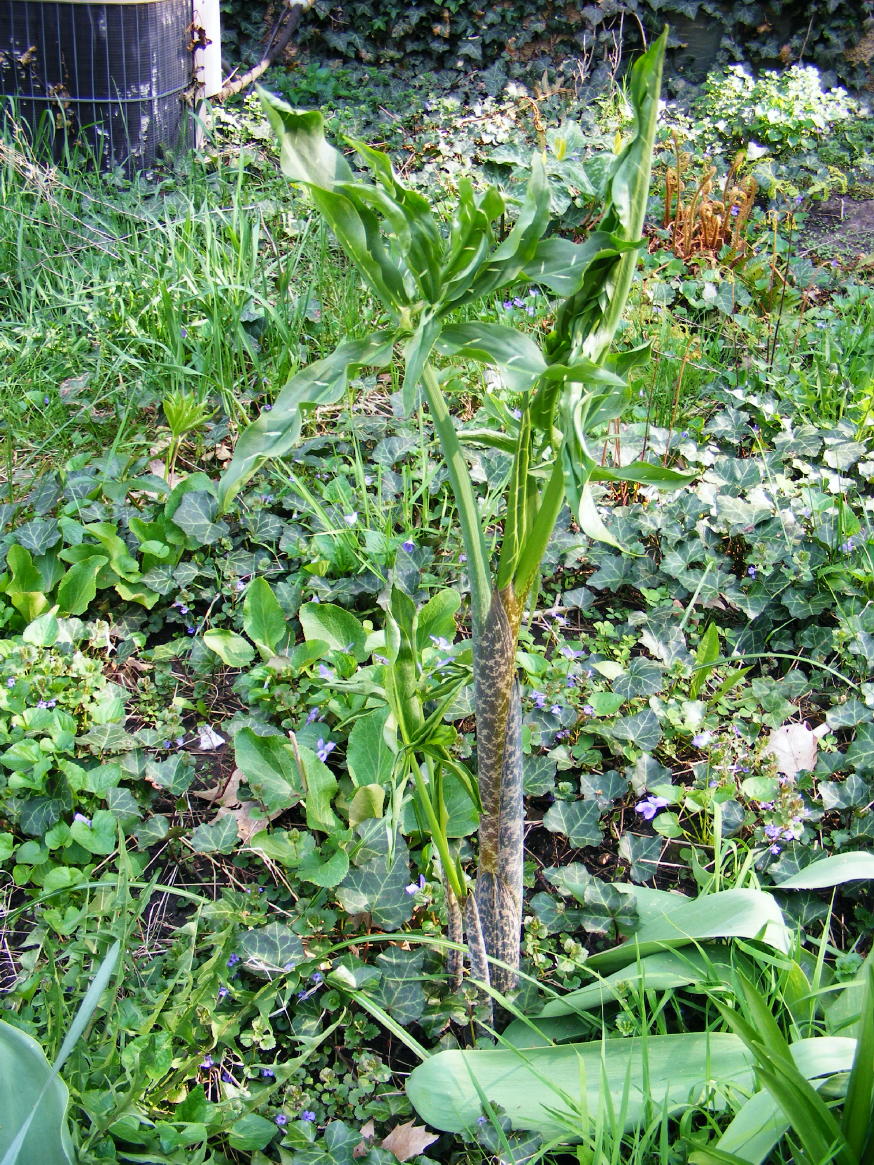 Since Fernymoss was out and about with the camera the other day, I thought I'd post another update on the Dragon Arum before it gets much bigger! He took this shot on Tuesday 6 May as the leaves were starting to unfurl in earnest, and wow it's moving fast to put on size this year! All four of the new shoots are leafing out (even the smallest one, which is rather hard to see in this shot), and at the rate it has been growing, it might well bloom about the same time this year (with any luck).
Since Fernymoss was out and about with the camera the other day, I thought I'd post another update on the Dragon Arum before it gets much bigger! He took this shot on Tuesday 6 May as the leaves were starting to unfurl in earnest, and wow it's moving fast to put on size this year! All four of the new shoots are leafing out (even the smallest one, which is rather hard to see in this shot), and at the rate it has been growing, it might well bloom about the same time this year (with any luck).
Tradition has it that Peonies should bloom on Memorial Day Weekend and last year they were right on time ... along with the Dragon Arum! What an odd combo to have in bloom, near each other at the same time ... the wonderful fragrance of Peonies, and the well, not so pretty stench of the Dragon Arum. Come to think of it though, aside from the first couple of days, we didn't really notice the smell too much ... or maybe the Peonies just overcompensated and overpowered it! In any case, I'll keep popping the occasional update here in anticipation of the big day ... so if you're interested, do come back!
Here's something fun (I hope) you can do with this photo ... there are four clearly visible other plants (not counting the sickly tulips in the foreground) in the proximity of the Arum, toward the back. See if you can identify some of them and let me know what you find!
A short note on posting this week ... I'm currently finishing up a big project for work, and may miss a day or so, but I've got lots more saved up to post when I have a little more time again. I've got a few drafts saved, so depending on how tired I am the next few days, I may still end up making some quick posts.
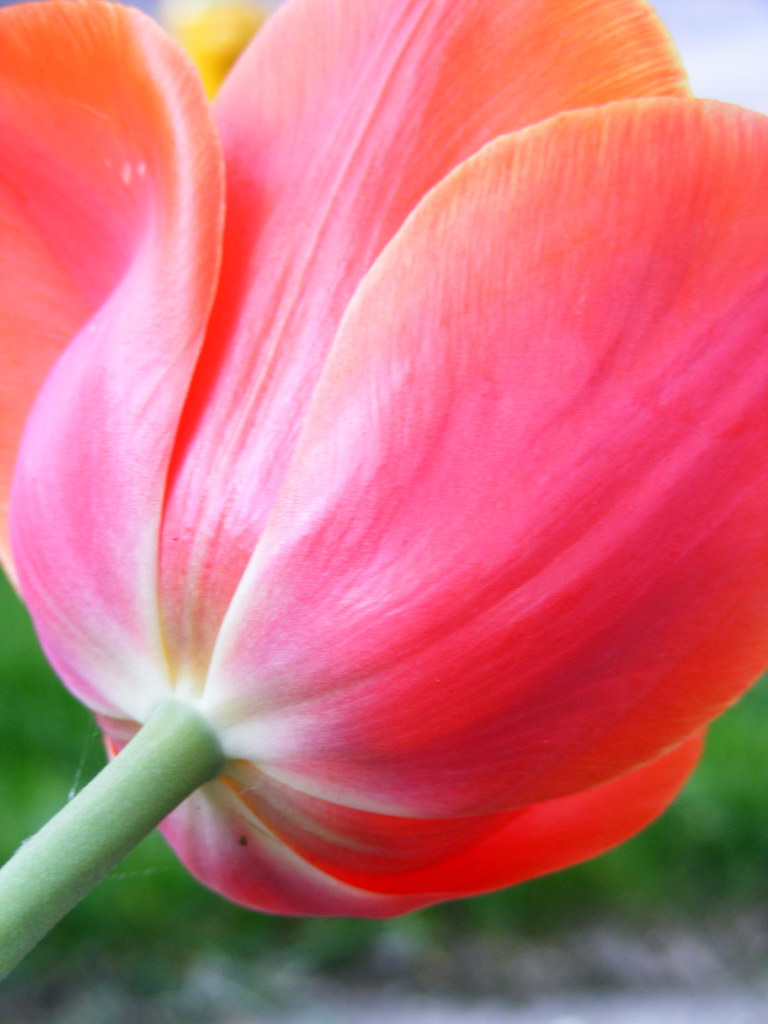
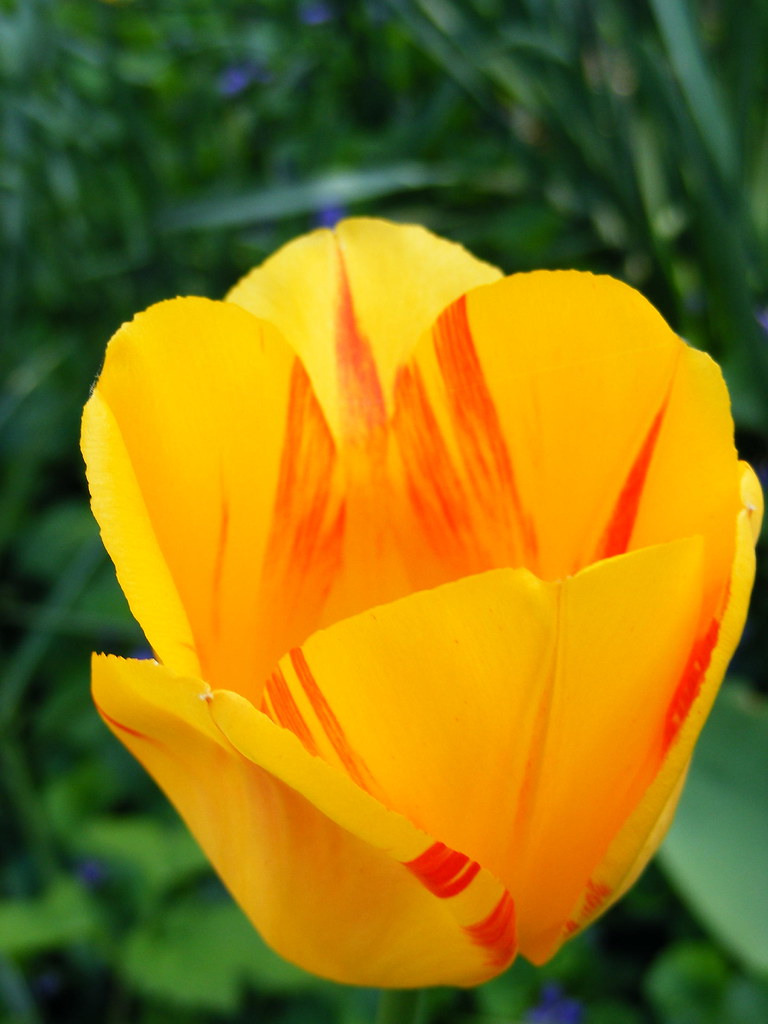 This shot is from a large set of photos that Fernymoss took on 26 April. I wish I could claim this one as my own because I really love the angle and degree of textures he was able to get in this shot. And though I had tried to get a shot of this one last weekend, it was too windy and I didn't end up with anything I liked ... but then I wasn't going for this angle either! The colour is very true to the actual flower, which boasts a delicious shading of pinks, salmon and orange. (It too, fortunately, is a survivor!)
This shot is from a large set of photos that Fernymoss took on 26 April. I wish I could claim this one as my own because I really love the angle and degree of textures he was able to get in this shot. And though I had tried to get a shot of this one last weekend, it was too windy and I didn't end up with anything I liked ... but then I wasn't going for this angle either! The colour is very true to the actual flower, which boasts a delicious shading of pinks, salmon and orange. (It too, fortunately, is a survivor!)
And since Boran2 liked the previous (closed up) shot of this Olympic Flame, the last of these favorites still around ... We will definitely be planting more of these in the Fall, along with the others. Actually as I recall, this particular variety isn't terribly expensive (but I think any decent Darwin type tulip under $1 is a good price), and it's pretty hardy and reliable, except when you have a spring like last year's around here ... Anyway, let's enjoy it while it lasts!
 When the likes of Chuck Todd (MSNBC electoral numbers guru extraordinaire) and Potato Head Russert say it's over, it's over. The mainstream media has now turned on you. (Whether that's fair or not is a good subject for debate.) Go away, Hillary. Your entitlement has evaporated, not that it was ever there to begin with ... not to mention that you campaigned arrogantly on your "inevitability" in Iowa.
When the likes of Chuck Todd (MSNBC electoral numbers guru extraordinaire) and Potato Head Russert say it's over, it's over. The mainstream media has now turned on you. (Whether that's fair or not is a good subject for debate.) Go away, Hillary. Your entitlement has evaporated, not that it was ever there to begin with ... not to mention that you campaigned arrogantly on your "inevitability" in Iowa.
You should have taken the hint on January 3, and in subsequent races, say those runs of wins for Obama in February? Give it up. Quit trying to foment civil war in the Democratic party and surrender your ego gracefully. You and Bill have turned former Clinton defenders and supporters (like myself) into people who absolutely loathe you both now. That's quite a legacy you leave behind. I went from being "Ok, if she gets the nomination, I'll hold my nose to vote for her," to "There's no way I can vote for her because we might as well elect a Republican, since she's one in every way but name." My current position rests that should she manage to steal the nomination from Obama, I will still vote. Not for her, not for McSame, but for Obama as a write-in. Then I'll proceed to vote for the down ticket races, trying to ignore the devastating damage she has (as presumed a Democrat as Joe LIEberman) wrought upon the Democratic party. When you have the likes of Rush Limbaugh urging people to vote for you, that says a lot. Sure, the Republicans want to run against her, but the fact remains that she is closer to their thinking than traditional Democratic values. That she's willing to appropriate a John (MSM teflon) McSame talking point vis-à-vis this stupid "gas tax holiday" is just shameful. Just change your party affiliation, Hillary and join LIEberman on the endangered species list. You and Bill are not fooling us anymore, you seek power for the sake of power, and consider yourselves entitled to swap the Bush-Clinton dynasty now and then. Enough already. Take your Crown Royal, go home, drink up and leave it to Obama to steer this country out of the morass in which we currently find ourselves. Hell, here are four aspirins and a piece of cheese to alleviate the hangover. That's as generous as I can be to you at this point.
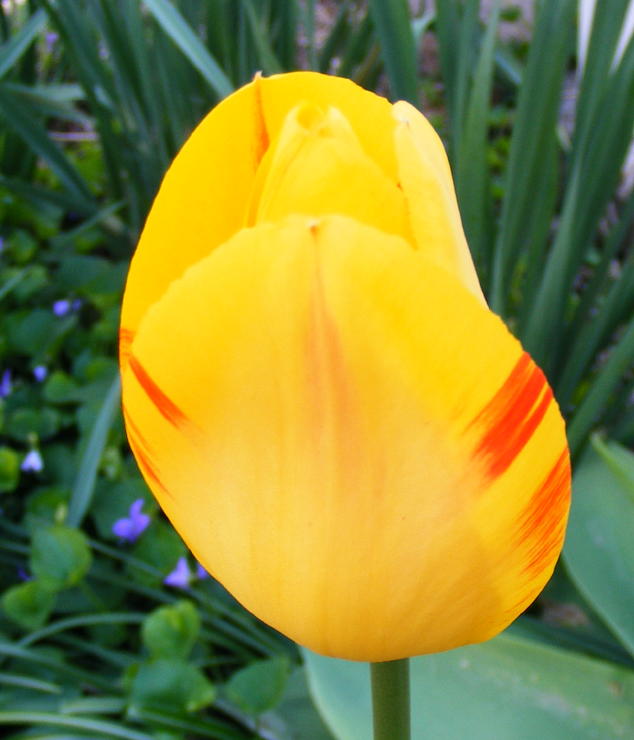 Tulips decimated this year ... whine whine whine ... send me some cheese to accompany it, will you please?
Tulips decimated this year ... whine whine whine ... send me some cheese to accompany it, will you please?
Ok, so it's not that bad, and I'm not really begging for cheese ... but if you do happen to have a nice, ripening triple crème brie, I'd be happy to take it off your hands! I might even share some with you, lol.
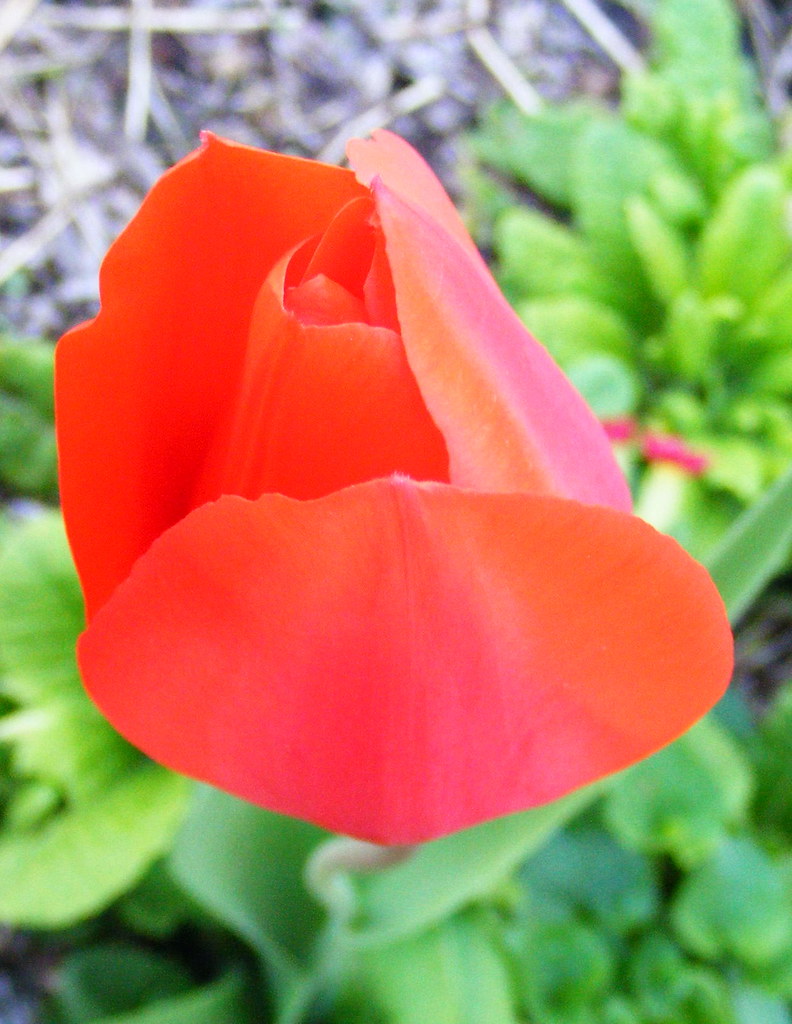 These two close ups are some of the survivors still left in the original bulb bed and by the sidewalk nearer the house. The first one,, perhaps my all time favorite, is Olympic Flame, and it looks like this is the last of the breed to make it. There used to be about eight of them and there were at least five last year. Even though it's a bit smaller than normal this year, it is managing to make a splash. There also used to be several yellow and red Parrot Tulips, but they too have disappeared.
These two close ups are some of the survivors still left in the original bulb bed and by the sidewalk nearer the house. The first one,, perhaps my all time favorite, is Olympic Flame, and it looks like this is the last of the breed to make it. There used to be about eight of them and there were at least five last year. Even though it's a bit smaller than normal this year, it is managing to make a splash. There also used to be several yellow and red Parrot Tulips, but they too have disappeared.
This basic Red Darwin is the lone tulip in the bed with the primroses (coming soon) and I'm not really sure how it got there. Years ago I planted a bunch of those Peony type Tulips and for a couple of years, foliage came up, but never any blooms, and then they just disappeared. And to think, they were Martha Stewart brand bulbs we got at KMart! Anyway, when we first moved in we discovered there were about 3-5 basic red tulips scattered around what passed as a flower bed back then. We just let them do their thing, but this one appears to have wandered over, or accidentally been brought in (perhaps with some dirt?) and now likes to bloom when the primroses do. It's a nice contrast, so I'm happy that it's here ... you can never have too many red tulips, as I say, hehe. And they positively go with everything!
I took these on 26 April, 2008, using of course the S700! The learning curve is still kind of low due to busy work schedule and crappy weather lately, but so far I'm thrilled how this is working out ...
 I thought that tonight I'd do something I probably don't do enough here, which is to give a more comprehensive look at the garden from a more global (ok, well maybe it should be continental) view. As regular readers know, I've been lamenting the devastating loss of more than half of the masses of tulips we had planted, so here's partial testimony to the extent of the damage caused by that abnormally long and cold few weeks we had last spring.
I thought that tonight I'd do something I probably don't do enough here, which is to give a more comprehensive look at the garden from a more global (ok, well maybe it should be continental) view. As regular readers know, I've been lamenting the devastating loss of more than half of the masses of tulips we had planted, so here's partial testimony to the extent of the damage caused by that abnormally long and cold few weeks we had last spring.
The tulips are actually performing a wee bit better than we expected them to in these areas, but keep in mind that where you now see a grouping there were once about 20 bulbs, each mass surrounded by a ring of about 20 grape hyacinths as well. A lot of the grape hyacinths seem to have succumbed as well, so overall, this portion of the front boulder bed is looking more than a bit wan this year.
This shot also affords a good perspective on some of the other perennials in this bed (at least the ones currently up). So here's what we have here, from the bottom left to right ... that crowded and happy looking clump of very green leaves just to the left of the tulips are the ever expanding Wood Hyacinths (Hyacinthoides hispanica) you'll in a few more weeks, as it's one of the very last bulbs to join the show in the late spring. To the right of the red tulips, we have an unknown variety (e.g. we lost the tag) of Artemisia, and the closest I've come (not very) to identifying it online is that it may be Artemisia pycnocephala, but I'm basing that entirely on the less than convincing picture in the Wikipedia entry. The blooms they show look pretty much like the ones on this plant. We planted it mostly for garden textural interest than for the blooms, and it's a vigorous grower that we have to cut back in early summer, lest it overwhelm everything around it. We also lost a few of its cousins this year as well, the 'Silver Mound' variety, Artemisia schmidtiana that I've been patiently tucking into spaces in the rocks out front. I will definitely be replacing those, because they've fast become one of my favorites among the Artemisias.
And to the right of the Artemisia in this photo, you'll find yet another clump of Wood Hyacinths. Directly behind it, and more to center of the bed, you can see a (still) very short plant coming up ... well this is some kind of minor miracle that I really hope pans out this year. It's a (reputedly purple) 'Turk's Cap' lily which I had given up for gone as recently as last year. But here it is! I'm hopeful we'll see something out of it this year, because they are a truly beautiful lily, and that's quite the praise coming from someone who's not really a fan of many of the fancy lilies cultivated today. I am hoping that in this case, the old garden adage of: the first year it sleeps, the second year it creeps, the third year it leaps. This is its third year here and I sure would love to see it do some leaping ...
Further back are tulips, of course and that maroon-purply-red mass of leaves is the ever expanding, and soon to be thinned out Lysimachia a friend gave us back in 2004 telling us that it was 'Yellow Bee Balm,' well that didn't quite pan out obviously once it got going, and now we fear that it may try to rule things out there, so it's soon due to meet the shovel or ax! It does have its merits, growing into a shrub like monstrosity with interesting foliage and very pretty proliferous yellow flowers. Beyond that, you can see the beginnings of the Woodland Garden, with that planting of Daffodils and Hyacinths which should look familiar as it is the one I featured in a post last week. Further beyond, you can see our Hollies (1 Male, 2 Female), behind which is an assortment of ferns, Bleeding Hearts (Dicentra spectabilis) and two species of Ligularia dentata, and Ligularia stenocephala which are now up but far from blooming stage yet. There are also several 'Alpine Blue' (Aquilegia alpina) in front of the hollies and when they're blooming you'll see them here. Of course there's a lot more going on than can be seen in this shot, but I'll plan on trying at least once a week from now on to get a 'documentary' shot up here so we can all gauge the progress over the coming months. Stay tuned ...
 Who knew they were this pretty? (Be sure to click through to the larger version.) I have to admit, I don't usually pay much attention to the Holly Blooms when they arrive in mid-spring, and generally just make a mental note along the lines of, oh, we'll have lots of berries this fall, and pretty much leave it at that. We've both tried a few macro shots in the past, but never have had much luck ... until the arrival of the S700 this year. Last week Fernymoss took another stab at shooting up close and hit pay dirt this time (so to speak). I never imagined they were so pretty --and inviting to insects-- but here they are! Quite lovely, I think ... and I'll pay closer attention to them in the future for sure. I think a lot of gardeners who grow 'Blue Princess' Holly (Ilex meserveae) probably pay much more attention to the brilliant red fall berries than the spring flowers. We've certainly been guilty of that offense! So here's my argument for getting up closer and really appreciating what they're doing to reward us with those lovely berries in the fall (which in our garden do seem to serve as a food source for certain winter birds) to brighten our Holiday decorations (though we hardly cut much at that time, mostly just leggy looking branches).
Who knew they were this pretty? (Be sure to click through to the larger version.) I have to admit, I don't usually pay much attention to the Holly Blooms when they arrive in mid-spring, and generally just make a mental note along the lines of, oh, we'll have lots of berries this fall, and pretty much leave it at that. We've both tried a few macro shots in the past, but never have had much luck ... until the arrival of the S700 this year. Last week Fernymoss took another stab at shooting up close and hit pay dirt this time (so to speak). I never imagined they were so pretty --and inviting to insects-- but here they are! Quite lovely, I think ... and I'll pay closer attention to them in the future for sure. I think a lot of gardeners who grow 'Blue Princess' Holly (Ilex meserveae) probably pay much more attention to the brilliant red fall berries than the spring flowers. We've certainly been guilty of that offense! So here's my argument for getting up closer and really appreciating what they're doing to reward us with those lovely berries in the fall (which in our garden do seem to serve as a food source for certain winter birds) to brighten our Holiday decorations (though we hardly cut much at that time, mostly just leggy looking branches). 